2019 California Standards for Accessible Design Guide (effective January 1, 2020 with July 1, 2021 amendments)
DIVISION 8: SPECIAL ROOMS, SPACES, AND ELEMENTS
11B-801.1 Scope.
The provisions of Division 8 shall apply where required by Division 2 or where referenced by a requirement in this chapter.

11B-802 Wheelchair spaces, companion seats, and designated aisle seats and semi-ambulant seats
[2010 ADA Standards] 802 Wheelchair Spaces, Companion Seats, and Designated Aisle Seats
11B-802.1.1 Floor or ground surface.
The floor or ground surface of wheelchair spaces shall comply with Section 11B-302. Changes in level, slopes exceeding 1:48, and detectable warnings shall not be permitted.
Exception: Reserved.
11B-802.1.2 Width.
A single wheelchair space shall be 36 inches (914 mm) wide minimum. Where two adjacent wheelchair spaces are provided, each wheelchair space shall be 33 inches (838 mm) wide minimum.

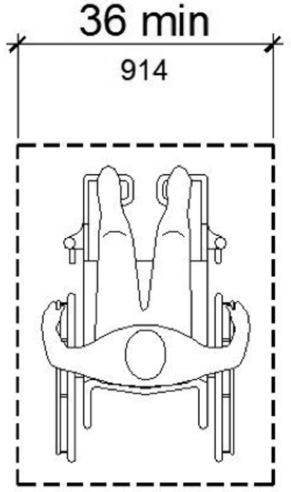
(a) single space
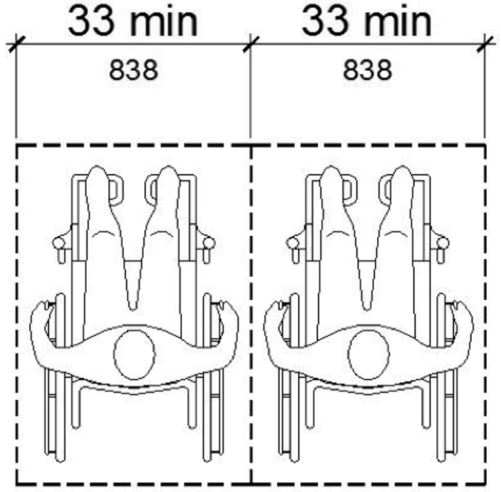
(b) two spaces
FIGURE 11B-802.1.2 WIDTH OF WHEELCHAIR SPACES
11B-802.1.3 Depth.
Where a wheelchair space can be entered from the front or rear, the wheelchair space shall be 48 inches (1219 mm) deep minimum. Where a wheelchair space can be entered only from the side, the wheelchair space shall be 60 inches (1524 mm) deep minimum.

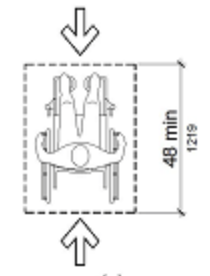
(a) front or rear entry
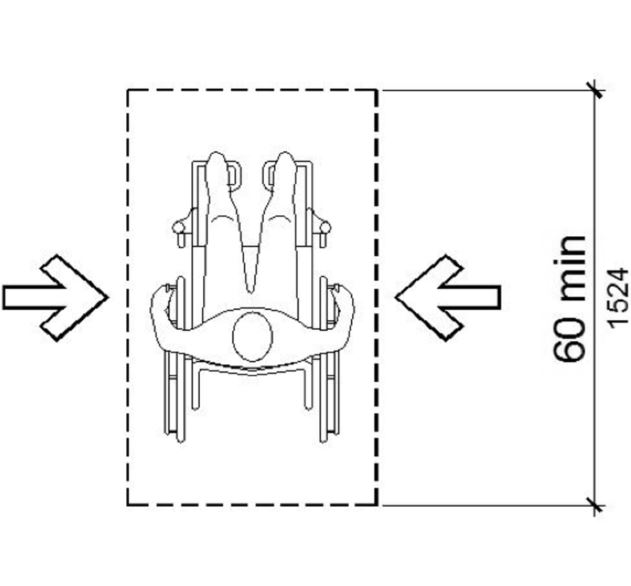
(b) side entry
FIGURE 11B-802.1.3 DEPTH OF WHEELCHAIR SPACES
11B-802.1.4 Approach.
Wheelchair spaces shall adjoin accessible routes. Accessible routes shall not overlap wheelchair spaces.

11B-802.1.5 Overlap.
Wheelchair spaces shall not overlap circulation paths.

11B-802.2 Lines of sight.
Lines of sight to the screen, performance area, or playing field for spectators in wheelchair spaces shall comply with Section 11B-802.2.
11B-802.2.1 Lines of sight over seated spectators.
Where spectators are expected to remain seated during events, spectators in wheelchair spaces shall be afforded lines of sight complying with Section 11B-802.2.1.
11B-802.2.1.1 Lines of sight over heads.
Where spectators are provided lines of sight over the heads of spectators seated in the first row in front of their seats, spectators seated in wheelchair spaces shall be afforded lines of sight over the heads of seated spectators in the first row in front of wheelchair spaces.
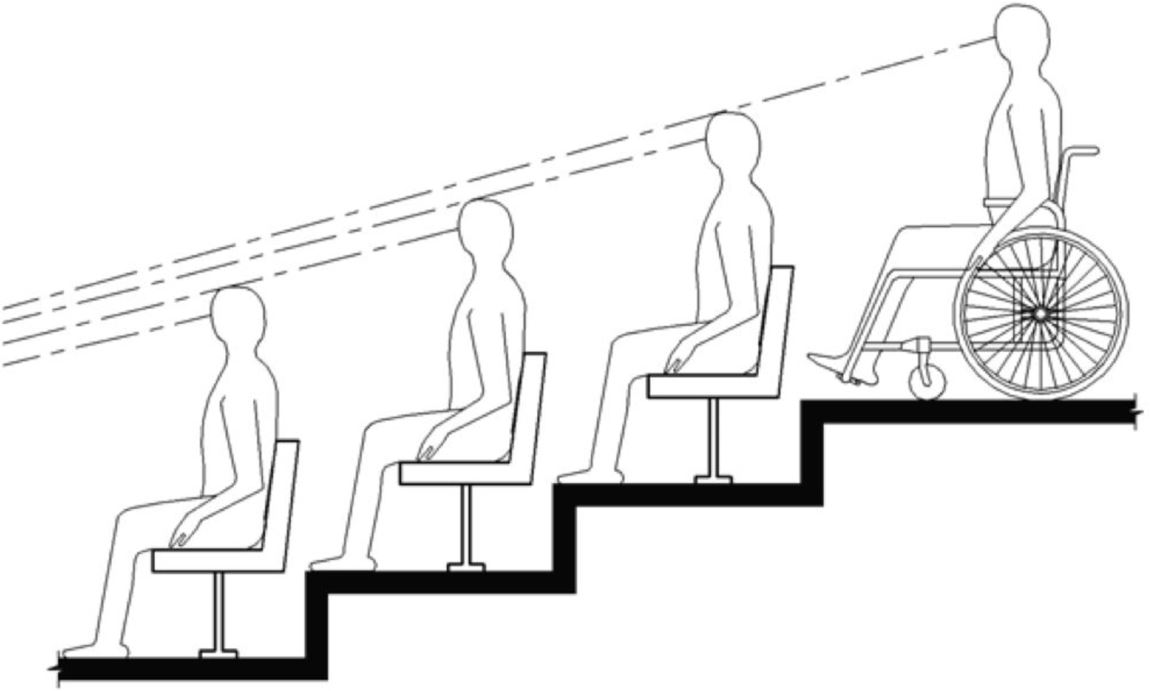
FIGURE 11B-802.2.1.1 LINES OF SIGHT OVER THE HEADS OF SEATED SPECTATORS
11B-802.2.1.2 Lines of sight between heads.
Where spectators are provided lines of sight over the shoulders and between the heads of spectators seated in the first row in front of their seats, spectators seated in wheelchair spaces shall be afforded lines of sight over the shoulders and between the heads of seated spectators in the first row in front of wheelchair spaces.
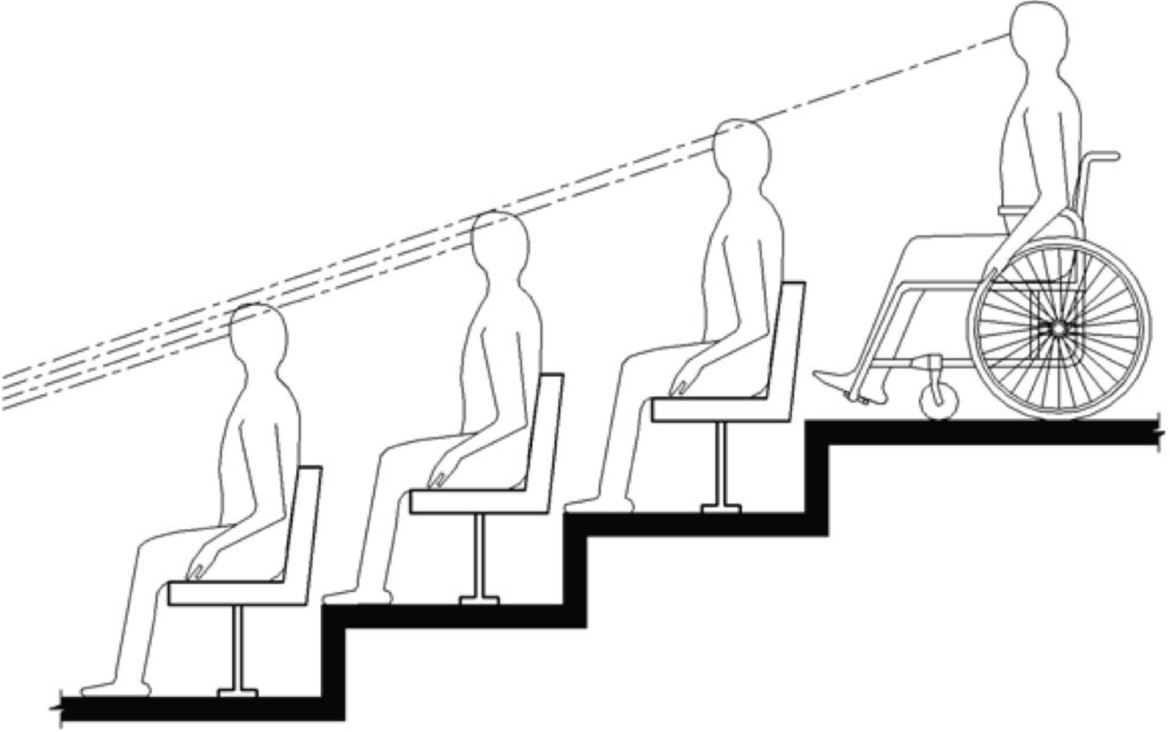
FIGURE 11B-802.2.1.2 LINES OF SIGHT BETWEEN THE HEADS OF SEATED SPECTATORS
11B-802.2.2 Lines of sight over standing spectators.
Where spectators are expected to stand during events, spectators in wheelchair spaces shall be afforded lines of sight complying with Section 11B-802.2.2.
11B-802.2.2.1 Lines of sight over heads.
Where standing spectators are provided lines of sight over the heads of spectators standing in the first row in front of their seats, spectators seated in wheelchair spaces shall be afforded lines of sight over the heads of standing spectators in the first row in front of wheelchair spaces.
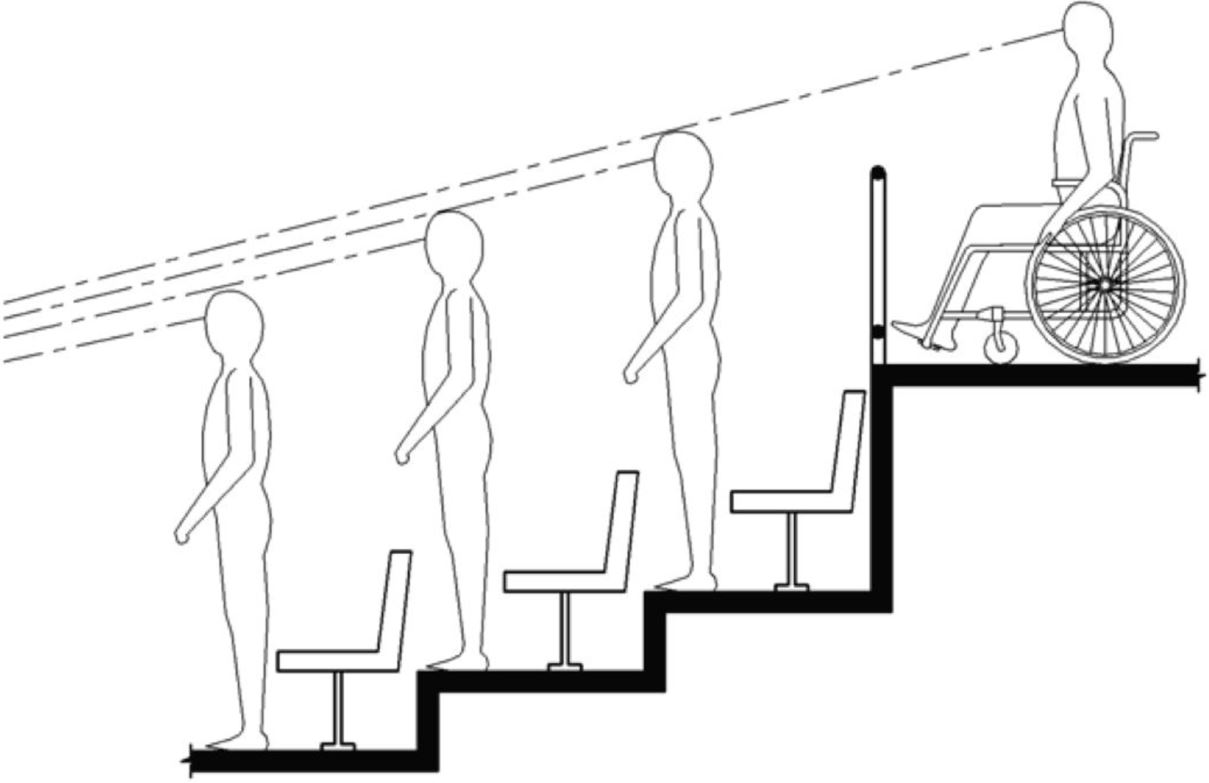
FIGURE 11B-802.2.2.1 LINES OF SIGHT OVER THE HEADS OF STANDING SPECTATORS
11B-802.2.2.2 Lines of sight between heads.
Where standing spectators are provided lines of sight over the shoulders and between the heads of spectators standing in the first row in front of their seats, spectators seated in wheelchair spaces shall be afforded lines of sight over the shoulders and between the heads of standing spectators in the first row in front of wheelchair spaces.
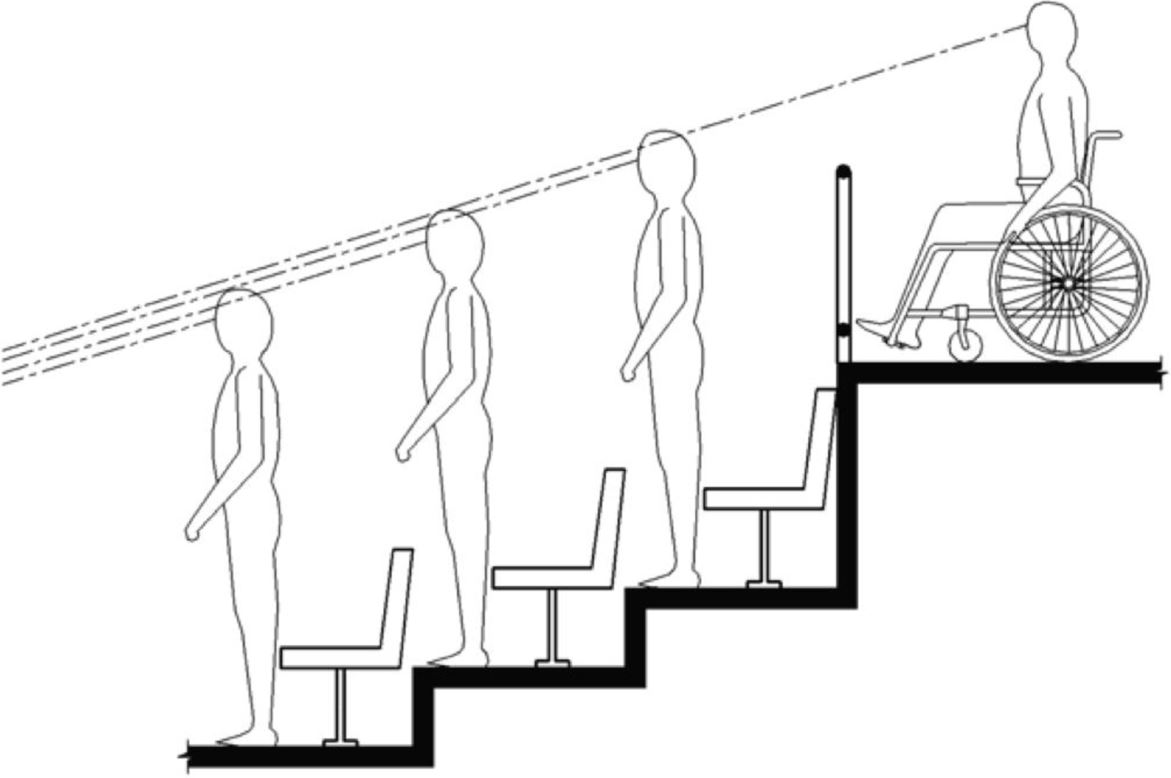
FIGURE 11B-802.2.2.2 LINES OF SIGHT BETWEEN THE HEADS OF STANDING SPECTATORS
11B-802.3 Companion seats.
Companion seats shall comply with Section 11B-802.3.
11B-802.3.1 Alignment.
In row seating, companion seats shall be located to provide shoulder alignment with adjacent wheelchair spaces. The shoulder alignment point of the wheelchair space shall be measured 36 inches (914 mm) from the front of the wheelchair space. The floor surface of the companion seat shall be at the same elevation as the floor surface of the wheelchair space.
11B-802.3.2 Type.
Companion seats shall be equivalent in size, quality, comfort, and amenities to the seating in the immediate area. Companion seats shall be permitted to be movable.
11B-802.4 Designated aisle seats.
Designated aisle seats shall comply with Section 11B-802.4.
11B-802.4.1 Armrests.
Where armrests are provided on the seating in the immediate area, folding or retractable armrests shall be provided on the aisle side of the seat.
11B-802.4.2 Identification.
Each designated aisle seat shall be identified by a sign or marker with the International Symbol of Accessibility complying with Section 11B-703.7.2.1. Signs complying with Section 11B-703.5, notifying patrons of the availability of such seats shall be posted at the ticket office.
[2010 ADA Standards] 802.4.2 Identification. Each designated aisle seat shall be identified by a sign or marker.


11B-802.5 Semi-ambulant seats.
Semi-ambulant seats shall provide at least 24 inches (610 mm) clear leg space between the front of the seat to the nearest obstruction or to the back of the seat immediately in front.
11B-803.1 General.
Dressing, fitting, and locker rooms shall comply with Section 11B-803.

11B-803.2 Turning space.
Turning space complying with Section 11B-304 shall be provided within the room.
11B-803.3 Door swing.
Doors shall not swing into the room unless a turning space complying with Section 11B-304.3 is provided beyond the arc of the door swing.
11B-803.4 Benches.
A bench complying with Section 11B-903 shall be provided within the room.
11B-803.5 Coat hooks and shelves.
Coat hooks provided within the room shall be located within one of the reach ranges specified in Section 11B-308. Shelves shall be 40 inches (1016 mm) minimum and 48 inches (1219 mm) maximum above the finish floor or ground. Coat hooks shall not be located above the bench or other seating in the room.
[2010 ADA Standards] 803.5 Coat Hooks and Shelves. Coat hooks provided within the room shall be located within one of the reach ranges specified in 308. Shelves shall be 40 inches (1015 mm) minimum and 48 inches (1220 mm) maximum above the finish floor or ground.
11B-803.6 Mirrors.
Mirrors shall be installed with the bottom edge of the reflecting surface 20 inches (508 mm) maximum above the finish floor or ground. Mirrors shall be full length with a reflective surface 18 inches (457 mm) wide minimum by 54 inches (1372 mm) high minimum and shall be mounted in a position affording a view to a person on the bench as well as to a person in a standing position.
11B-804.2 Clearance.
Where a pass through kitchen is provided, clearances shall comply with Section 11B-804.2.1. Where a U-shaped kitchen is provided, clearances shall comply with Section 11B-804.2.2.
Exception: Spaces that do not provide a cooktop or conventional range shall not be required to comply with Section 11B-804.2.

11B-804.2.1 Pass through kitchen.
In pass through kitchens where counters, appliances or cabinets are on two opposing sides, or where counters, appliances or cabinets are opposite a parallel wall, clearance between all opposing base cabinets, counter tops, appliances, or walls within kitchen work areas shall be 40 inches (1016 mm) minimum. Pass through kitchens shall have two entries.
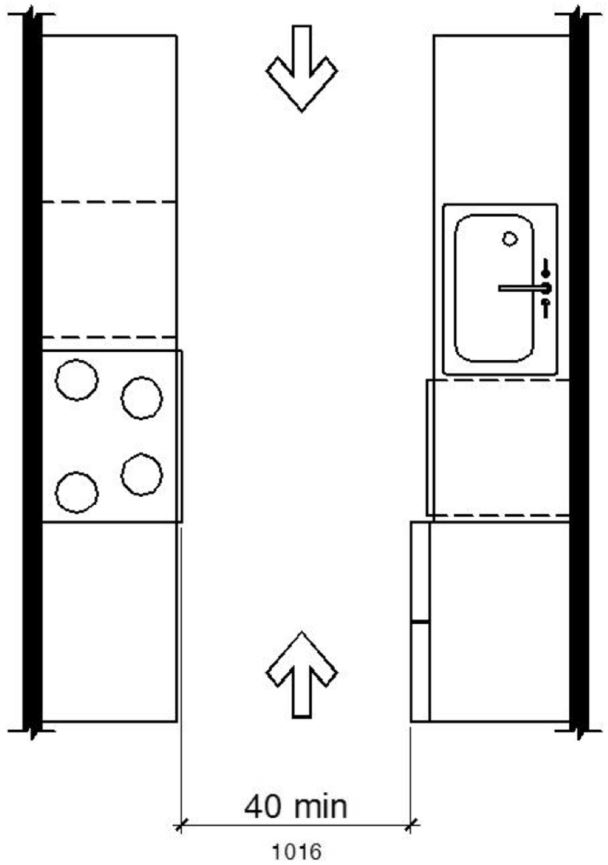
FIGURE 11B-804.2.1 PASS THROUGH KITCHENS
11B-804.2.2 U-Shaped.
In U-shaped kitchens enclosed on three contiguous sides, clearance between all opposing base cabinets, counter tops, appliances, or walls within kitchen work areas shall be 60 inches (1524 mm) minimum.
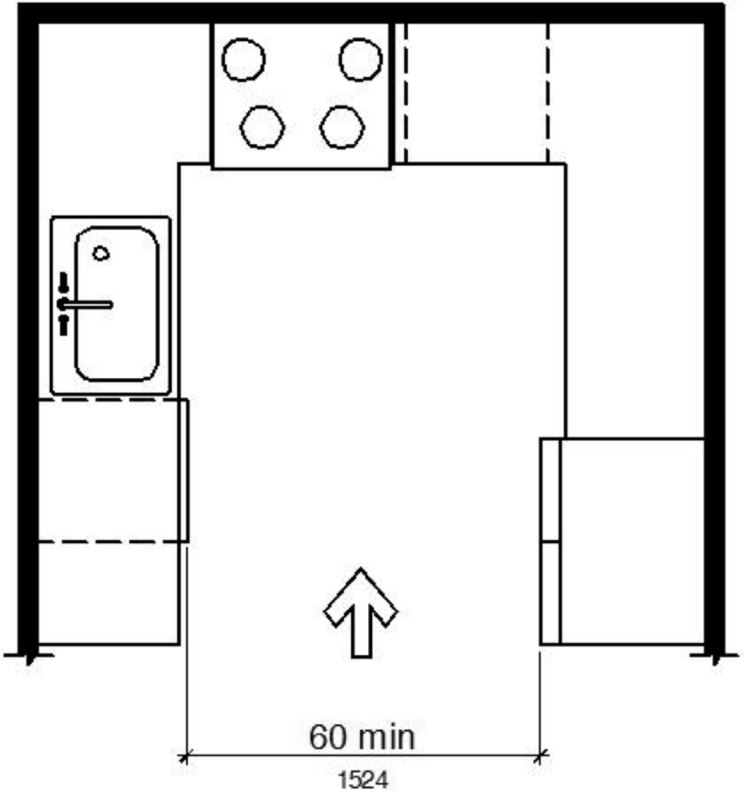
(a)
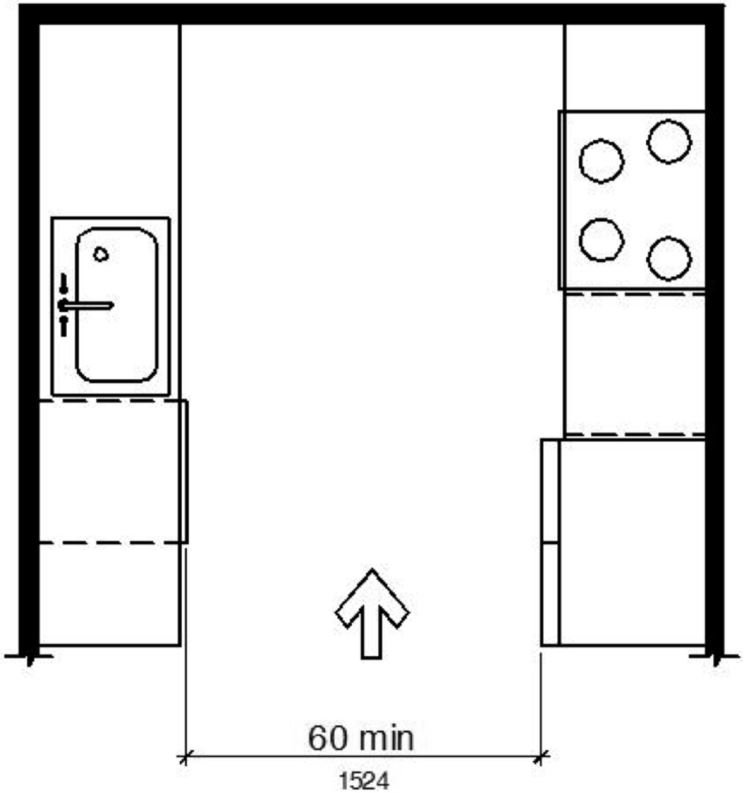
(b)
FIGURE 11B-804.2.2 U-SHAPED KITCHENS
11B-804.2.3 Turning space.
In kitchens within multi-bedroom housing units and on floors containing accessible sleeping rooms with adaptable features in undergraduate student housing, turning spaces complying with Section 11B-304 shall be provided.
11B-804.3 Kitchen work surface.
In residential dwelling units required to comply with Section 11B-809, at least one 30 inches (762 mm) wide minimum section of counter shall provide a kitchen work surface that complies with Section 11B-804.3. In kitchens within multi-bedroom housing units and on floors containing accessible sleeping rooms with adaptable features in undergraduate student housing, at least one 30 inches (762 mm) wide minimum section of counter shall provide a kitchen work surface that complies with Section 11B-804.3.
11B-804.3.1 Clear floor or ground space.
A clear floor space complying with Section 11B-305 positioned for a forward approach shall be provided. The clear floor or ground space shall be centered on the kitchen work surface and shall provide knee and toe clearance complying with Section 11B-306.
Exception: Cabinetry shall be permitted under the kitchen work surface provided that all of the following conditions are met:
(a) the cabinetry can be removed without removal or replacement of the kitchen work surface;
(b) the finish floor extends under the cabinetry; and
(c) the walls behind and surrounding the cabinetry are finished.
11B-804.3.2 Height.
The kitchen work surface shall be 34 inches (864 mm) maximum above the finish floor or ground.
Exception: A counter that is adjustable to provide a kitchen work surface at variable heights, 29 inches (737 mm) minimum and 36 inches (914 mm) maximum, shall be permitted.
11B-804.3.3 Exposed surfaces.
There shall be no sharp or abrasive surfaces under the work surface counters.
11B-804.5 Storage.
At least 50 percent of shelf space in storage facilities shall comply with Section 11B-811.
11B-804.6 Appliances.
Where provided, kitchen appliances shall comply with Section 11B-804.6.
11B-804.6.1 Clear floor or ground space.
A clear floor or ground space complying with Section 11B-305 shall be provided at each kitchen appliance. Clear floor or ground spaces shall be permitted to overlap.
11B-804.6.2 Operable parts.
All appliance controls shall comply with Section 11B-309.
Exceptions:
- Appliance doors and door latching devices shall not be required to comply with Section 11B-309.4.
- Bottom-hinged appliance doors, when in the open position, shall not be required to comply with Section 11B-309.3.
11B-804.6.3 Dishwasher.
Clear floor or ground space shall be positioned adjacent to the dishwasher door. The dishwasher door, in the open position, shall not obstruct the clear floor or ground space for the dishwasher or the sink.
11B-804.6.4 Range or cooktop.
Where a forward approach is provided, the clear floor or ground space shall provide knee and toe clearance complying with Section 11B-306. Where knee and toe space is provided, the underside of the range or cooktop shall be insulated or otherwise configured to prevent burns, abrasions, or electrical shock. The location of controls shall not require reaching across burners.
11B-804.6.5.1 Side-hinged door ovens.
Side-hinged door ovens shall have the work surface required by Section 11B-804.3 positioned adjacent to the latch side of the oven door.
11B-804.6.5.2 Bottom-hinged door ovens.
Bottom-hinged door ovens shall have the work surface required by Section 11B-804.3 positioned adjacent to one side of the door.
11B-804.6.5.3 Controls.
Ovens shall have controls on front panels.
11B-804.6.6 Refrigerator/freezer.
Combination refrigerators and freezers shall have at least 50 percent of the freezer space 54 inches (1372 mm) maximum above the finish floor or ground. The clear floor or ground space shall be positioned for a parallel approach to the space dedicated to a refrigerator/freezer with the centerline of the clear floor or ground space offset 24 inches (610 mm) maximum from the centerline of the dedicated space.
11B-805 Medical care and long-term care facilities
ETA Editor's Note
The numbering of subsections within Section 11B-805 is not aligned between CBC and 2010 ADA Standards. The CBC requirements are considerably more extensive, as indicated by the italicized requirements below.
11B-805.1 General.
Medical care facilities and long-term care facilities shall comply with Section 11B-805. All common use spaces and public use spaces in medical care facilities and long-term care facilities shall comply with this chapter.
[2010 ADA Standards] 805.1 General. Medical care facility and long-term care facility patient or resident sleeping rooms required to provide mobility features shall comply with 805.
11B-805.2 Patient bedrooms and resident sleeping rooms.
Patient bedrooms and resident sleeping rooms required to provide mobility features shall comply with Section 11B-805.2.
ETA Editor's Note
According to the Office of Statewide Health Planning and Development (OSHPD), "resident sleeping rooms," not defined in CBC Chapter 2, refers to the bedrooms of long-term care occupants. The scoping for accessibility of On-Call Rooms for physicians and other staff is addressed at Subsection 11B-223.2.3, and these are treated as Transient Lodging components.
11B-805.2.1 Hand washing fixtures.
Hand washing fixtures shall comply with Section 11B-606.
11B-805.2.2 Beds.
A 36 inch (914 mm) minimum wide clear space shall be provided along the full length of each side of the beds.
[2010 ADA Standards] 805.3 Clear Floor or Ground Space. A clear floor space complying with 305 shall be provided on each side of the bed. The clear floor space shall be positioned for parallel approach to the side of the bed.
11B-805.2.3 Turning space.
Turning space complying with Section 11B-304 shall be provided within the room.
11B-805.2.4 Toilet and bathing rooms.
Toilet and bathing rooms that are provided as part of patient bedrooms and resident sleeping rooms complying with Section 11B-223.2 or 11B-223.3 shall comply with Section 11B-603. Where provided, one water closet, one lavatory, and one bathtub or shower shall comply with the applicable requirements of Sections 11B-603 through 11B-610.
[2010 ADA Standards] 805.4 Toilet and Bathing Rooms. Toilet and bathing rooms that are provided as part of a patient or resident sleeping room shall comply with 603. Where provided, no fewer than one water closet, one lavatory, and one bathtub or shower shall comply with the applicable requirements of 603 through 610.
11B-805.3 Waiting rooms.
Waiting rooms shall comply with Section 11B-805.3.
11B-805.3.1 Wheelchair spaces.
Where seating is provided in waiting rooms, at least 5 percent of the seating shall be wheelchair spaces complying with Section 11B-802.1.
Exception: In waiting rooms serving facilities specializing in treating conditions that affect mobility, 10 percent of the seating shall be wheelchair spaces complying with Section 11B-802.1.
11B-805.4 Examination, diagnostic and treatment rooms.
Examination, diagnostic and treatment rooms shall comply with Section 11B-805.4.
ETA Editor's Note
The Office of Statewide Health Planning and Development (OSHPD), which has jurisdiction over hospitals and long-term care facilities in California, issued Code Application Notice CAN 2-11B, dated 9/9/14, which includes the following interpretation of Section 11B-805.4:
Examination, diagnostic and treatment rooms refer to all patient care areas and include but are not limited to: exam rooms, treatment rooms, imaging rooms, operating rooms, emergency rooms, post anesthesia recovery rooms/units, dialysis rooms/units, infusion rooms/units, labor/delivery/recovery rooms and observation rooms/units. All examination, diagnostic and treatment rooms shall be accessible. Toilet rooms that are accessed from an examination, diagnostic or treatment room shall also be accessible. Note that all patient toilet rooms, other than those specifically exempted (i.e. non-accessible patient rooms and ICU patient rooms), must comply with Section 11B-603.
This is a scoping requirement, apparently misplaced outside Chapter 11B, Division 2.
As of the initial publication of this Guide, OSHPD has not updated CAN 2-11B for applicability to 2019 CBC. Since there is no change to the wording of Subsection 11B-805.4 from 2013 CBC to 2019 CBC, there is no reason to expect that OSHPD will change its interpretation.
11B-805.4.1 Beds, exam tables, procedure tables, gurneys and lounge chairs.
A 36 inch (914 mm) minimum wide clear space shall be provided along the full length of each side of beds, exam tables, procedure tables, gurneys and lounge chairs.
Exception: General exam rooms in non-emergency settings may provide clear space on only one side of beds, gurneys and exam tables.
11B-805.4.2 Equipment.
Clear space complying with Section 11B-305.2 shall be provided as required for specific equipment.
11B-805.4.3 Turning space.
Turning space complying with Section 11B-304 shall be provided within the room.
ETA Editor's Note
The Office of Statewide Health Planning and Development (OSHPD), which has jurisdiction over hospitals and long-term care facilities in California, issued Code Application Notice CAN 2-11B, dated 9/9/14, which includes the following interpretation of Subsections 11B-805.4.1, 11B-805.4.2 and 11B-805.4.3:
All patient care areas must provide access to the area and to the bed, exam table, procedure table, gurney, lounge chair and/or equipment/apparatus associated with the delivery of care, exam, diagnosis or treatment performed in the space. Access includes compliance with Division 4 of Chapter 11B for travel to, and circulation within, the patient care area; and turning space in compliance with Section 11B-304. A minimum of a 36-inch wide access shall be provided to and along each side of the bed, exam table, procedure table, gurney, lounge chair and/or equipment/apparatus. "Each side" includes both sides and the foot, but does not include the head unless the provision of care requires it. Refer to the following examples:
Exam room - Exam rooms are required to provide a turning space, accessible handwashing fixture, and 36-inch wide access along the full length of each side and the foot of the exam table. The exception is in reference to general exam rooms only. These are restricted to those meeting the definition of exam room in CBC Section 1224.3. Specific exam rooms required to be larger than 80 square feet are not considered "general exam rooms" and are not eligible for the exception.
Treatment room - Treatment rooms are required to provide a turning space, accessible handwashing fixture, accessible counter and writing surface, and 36-inch wide access along the full length of each side and foot of the treatment table. If the treatment room is intended to accommodate procedures requiring access to the head (e.g. minor surgery, etc.), all four sides of the table require 36-inch wide access.
Equipment - Exam or treatment rooms with equipment such as imaging must provide a turning space, accessible handwashing fixture if required, and 36-inch wide access to both sides and the foot of the table. The head of the equipment does not require 36-inch access if only used for servicing.
CBC Chapter 12, Section 1224 applies to hospitals, and 1224.3, referenced above, includes the following definition: EXAM ROOM. A room with a bed, stretcher, or examination table and capability for periodic monitoring (e.g., measurement of blood pressure or pulse oximetry) in which procedures that do not require a specialized suite can be performed (e.g., pelvic examination, blood transfusion).
OSHPD has not yet made it clear which, if any, movable items are allowed within the required 36-inch wide access.
As of the initial publication of this Guide, OSHPD has not updated CAN 2-11B for applicability to 2019 CBC. Since there is no change to the wording of Subsections 11B-805.4.1, 11B-805.4.2 and 11B-805.4.3 from 2013 CBC to 2019 CBC, there is no reason to expect that OSHPD will change its interpretation.
11B-805.5 Patient change areas.
Areas where patients change or are prepared for a procedure shall comply with Section 11B-222.
11B-805.6 Hand washing fixtures, lavatories and sinks.
All hand washing fixtures, lavatories and sinks shall comply with Section 11B-606.
Exception: Scrub sinks, as defined in California Plumbing Code Section 221.0, shall not be required to comply with Section 11B-606.
ETA Editor's Note
The Office of Statewide Health Planning and Development (OSHPD), which has jurisdiction over hospitals and long-term care facilities in California, issued Code Application Notice CAN 2-11B, dated 9/9/14, which includes the following interpretation of Section 11B-805.6:
The requirements of Section 11B-606 apply to all lavatories, sinks, and handwashing fixtures for public use, patient use, and employee use, unless otherwise specifically exempted by the code. Lavatories, sinks, and handwashing fixtures are common use areas and therefore, require accessibility.
Exceptions:
- Scrub sinks (due to impracticality)
- Specific workstations (see Section 11B-203.9). This applies only where the sink is the actual workstation.
Example: A sink used exclusively for cleaning endoscopes. The sink is the actual area where work is performed as opposed to a place where the employee cleans up before and after performing work elsewhere in the room.
Knee clearance requirement - All accessibility requirements of Section 11B-606 apply to lavatories, sinks and handwashing fixtures required to be accessible. Lavatories are subject to Section 11B-306.3.3, Exception 1 which states: "At lavatories required to be accessible by Section 11B-213.3.4, the knee clearance shall be 27 inches (686 mm) high minimum above the finish floor or ground at a depth of 8 inches (203 mm) minimum increasing to 29 inches (737 mm) high minimum above the finish floor or ground at the front edge of a counter with a built-in lavatory or at the front edge of a wall-mounted lavatory fixture."
This requirement applies to all lavatories. "Handwashing fixtures" are special application "sinks" and not subject to the exception. Handwashing fixtures, as sinks, are subject to Section 11B-306.2.3, Exception 1 which states" "The toe clearance shall extend 19 inches minimum under sinks required to be accessible by Section 11B-212.3."
Consequently, handwashing fixtures must have a minimum depth of 19 inches in order to comply with the minimum toe clearance. They shall also have a minimum knee clearance of 27 inches at the depth and reduction described in Sections 11B-306.3.3 and 11B-306.3.4.
The implications of this interpretation are that a wall-mounted china fixture of the most common size, nominally 20 inches wide x 18 inch projection, cannot serve as a handwashing fixture. See also the ETA Editor's Note at 11B-212.3.
As of the initial publication of this Guide, OSHPD has not updated CAN 2-11B for applicability to 2019 CBC. Since there is no change to the wording of Section 11B-805.6 from 2013 CBC to 2019 CBC, there is no reason to expect that OSHPD will change its interpretation.
11B-805.7 Built-in cabinets and work surfaces.
Built-in cabinets, counters and work surfaces shall be accessible, including: patient wardrobes, nurse’s stations, administrative centers, reception desks, medicine preparation areas, laboratory work stations, equipment consoles, clean and soiled utility cabinets, and storage areas; and shall comply with Sections 11B-225 and 11B-902.
Exceptions:
- Built-in wardrobes in patient bedrooms and resident sleeping rooms not required to be accessible are not required to comply with the provisions of this chapter.
- Clinical laboratory work stations provided in a laboratory area that are in addition to the minimum number required to be accessible (5 percent of the work stations provided, but no fewer than one), are not required to comply with the provisions of Section 11B-902.
ETA Editor's Note
The Office of Statewide Health Planning and Development (OSHPD), which has jurisdiction over hospitals and long-term care facilities in California, issued Code Application Notice CAN 2-11B, dated 9/9/14, which includes the following interpretation of Section 11B-805.7:
Built-in equipment consoles include recessed or wall mounted Electronic Medical Record (EMR) systems. These units must also comply with US Access Board Section 508 Standards for Electronic and Information Technology. A 30-inch by 48-inch clear floor space, in compliance with Section 11B-305, shall be centered in front of the display screen. Wall-mounted units shall comply with protrusion limits prescribed in Section 11B-307.2. Touch screen units shall be allowed to be vertically mounted with the centerline of the display screen no more than 52 inches above the floor in compliance with Section 11B-707.7.1.1. These units will need the capability of an alternate input method such as a wireless keyboard made available to those who would need it.
As of the initial publication of this Guide, OSHPD has not updated CAN 2-11B for applicability to 2019 CBC. Since there is no change to the wording of Section 11B-805.7 from 2013 CBC to 2019 CBC, there is no reason to expect that OSHPD will change its interpretation.
11B-806.1 General.
Transient lodging guest rooms shall comply with Section 11B-806. Guest rooms required to provide mobility features shall comply with Section 11B-806.2. Guest rooms required to provide communication features shall comply with Section 11B-806.3.
11B-806.2 Guest rooms with mobility features.
Guest rooms required to provide mobility features shall comply with Section 11B-806.2.

11B-806.2.1 Living and dining areas.
Living and dining areas shall be accessible.
11B-806.2.2 Exterior spaces.
Exterior spaces, including patios, terraces and balconies that serve the guest room shall be accessible.
11B-806.2.3 Sleeping areas.
At least one sleeping area shall provide a 36 inch (914 mm) by 48 inch (1219 mm) minimum clear space on both sides of a bed. The clear space shall be positioned for parallel approach to the side of the bed.
[2010 ADA Standards] 806.2.3 Sleeping Areas. At least one sleeping area shall provide a clear floor space complying with 305 on both sides of a bed. The clear floor space shall be positioned for parallel approach to the side of the bed.
Exception: Where a single clear floor space complying with Section 11B-305 positioned for parallel approach is provided between two beds, a clear floor or ground space shall not be required on both sides of a bed.
11B-806.2.3.1 Personal lift device floor space.
There shall be a clear space under the bed for the use of a personal lift device. The clear space shall extend under the bed parallel to the long side and be adjacent to an accessible route. The clear space shall extend to points horizontally 30 inches (762 mm), vertically 7 inches (178 mm) and not more than 12 inches (305 mm) from the head and foot end of the bed.
ETA Editor's Note
The clearance prescribed for a personal lift device at CBC 11B-806.2.3.1 is not required by 2010 ADA Standards.
11B-806.2.4 Toilet and bathing facilities.
At least one bathroom that is provided as part of a guest room shall comply with Section 11B-603. No fewer than one water closet, one lavatory, and one bathtub or shower shall comply with applicable requirements of Sections 11B-603 through 11B-610. In addition, required roll-in shower compartments shall comply with Section 11B-608.2.2 or 11B- 608.2.3. Toilet and bathing fixtures required to comply with Sections 11B-603 through 11B-610 shall be permitted to be located in more than one toilet or bathing area, provided that travel between fixtures does not require travel between other parts of the guest room.
11B-806.2.4.1 Vanity counter top space.
If vanity counter top space is provided in non-accessible guest toilet or bathing rooms, comparable vanity counter top space, in terms of size and proximity to the lavatory, shall also be provided in accessible guest toilet or bathing rooms.

11B-806.2.5 Kitchens, kitchenettes and wet bars. Kitchens, kitchenettes and wet bars shall comply with Section 11B-804.
[2010 ADA Standards] 806.2.5 Kitchens and Kitchenettes. Kitchens and kitchenettes shall comply with 804.
11B-806.2.6 Turning space.
Turning space complying with Section 11B-304 shall be provided within the guest room.
11B-806.3 Guest rooms with communication features.
Guest rooms required to provide communication features shall comply with Section 11B-806.3.

11B-806.3.1 Alarms.
Where emergency warning systems are provided, fire alarms shall comply with Section 11B-702 and carbon monoxide alarms shall comply with Chapter 4.
[2010 ADA Standards] 806.3.1 Alarms. Where emergency warning systems are provided, alarms complying with 702 shall be provided.
11B-806.3.2 Notification devices.
Visible notification devices shall be provided to alert room occupants of incoming telephone calls and a door knock or bell. Notification devices shall not be connected to visible alarm signal appliances. Telephones shall have volume controls compatible with the telephone system and shall comply with Section 11B-704.3. Telephones shall be served by an electrical outlet complying with Section 11B-309 located within 48 inches (1219 mm) of the telephone to facilitate the use of a TTY.
11B-807.1 General.
Holding cells and housing cells shall comply with Section 11B-807.
11B-807.2 Cells with mobility features.
Cells required to provide mobility features shall comply with Section 11B-807.2.
11B-807.2.1 Turning space.
Turning space complying with Section 11B-304 shall be provided within the cell.
11B-807.2.2 Benches.
Where benches are provided, at least one bench shall comply with Section 11B-903.
11B-807.2.3 Beds.
Where beds are provided, clear floor space complying with Section 11B-305 shall be provided on at least one side of the bed. The clear floor space shall be positioned for parallel approach to the side of the bed.
11B-807.2.4 Toilet and bathing facilities.
Toilet facilities or bathing facilities that are provided as part of a cell shall comply with Section 11B-603. Where provided, no fewer than one water closet, one lavatory, and one bathtub or shower shall comply with the applicable requirements of Sections 11B-603 through 11B-610.

11B-807.3 Cells with communication features.
Cells required to provide communication features shall comply with Section 11B-807.3.
11B-807.3.1 Alarms.
Where audible emergency alarm systems are provided to serve the occupants of cells, visible alarms complying with Section 11B-702 shall be provided.
Exception: Visible alarms shall not be required where inmates or detainees are not allowed independent means of egress.
11B-807.3.2 Telephones.
Telephones, where provided within cells, shall have volume controls complying with Section 11B-704.3.
11B-808.1 General.
Courtrooms shall comply with Section 11B-808.
11B-808.2 Turning space.
Where provided, areas that are raised or depressed and accessed by ramps or platform lifts with entry ramps shall provide unobstructed turning space complying with Section 11B-304.
11B-808.3 Clear floor space.
Each jury box and witness stand shall have, within its defined area, clear floor space complying with Section 11B-305.
Exception: In alterations, wheelchair spaces are not required to be located within the defined area of raised jury boxes or witness stands and shall be permitted to be located outside these spaces where ramp or platform lift access poses a hazard by restricting or projecting into a means of egress required by the appropriate administrative authority.
11B-808.4 Judges' benches and courtroom stations.
Judges' benches, clerks' stations, bailiffs' stations, deputy clerks' stations, court reporters' stations and litigants' and counsel stations shall comply with Section 11B-902.
11B-809.1 General.
When located within public housing facilities, residential dwelling units shall comply with Section 11B-809. Residential dwelling units required to provide mobility features shall comply with Sections 11B-809.2 through 11B-809.4. Residential dwelling units required to provide communication features shall comply with Section 11B-809.5.
[2010 ADA Standards] 809.1 General. Residential dwelling units shall comply with 809. Residential dwelling units required to provide mobility features shall comply with 809.2 through 809.4. Residential dwelling units required to provide communication features shall comply with 809.5.
11B-809.2 Accessible routes.
Accessible routes complying with Division 4 shall be provided within residential dwelling units in accordance with Section 11B-809.2.
Exception: Accessible routes shall not be required to or within unfinished attics or unfinished basements.
11B-809.2.1 Location.
At least one accessible route shall connect all spaces and elements which are a part of the residential dwelling unit. Where only one accessible route is provided, it shall not pass through bathrooms, closets, or similar spaces.
11B-809.2.2 Turning space.
All rooms served by an accessible route shall provide a turning space complying with Section 11B-304.
Exception: Turning space shall not be required in exterior spaces 30 inches (762 mm) maximum in depth or width.

11B-809.3 Kitchen.
Where a kitchen is provided, it shall comply with Section 11B-804.
11B-809.4 Toilet facilities and bathing facilities.
At least one bathroom shall comply with Section 11B-603. No fewer than one of each type of fixture provided within the bathroom shall comply with applicable requirements of Sections 11B-603 through 11B-610. Toilet and bathing fixtures required to comply with Sections 11B-603 through 11B-610 shall be located in the same bathroom or toilet and bathing area, such that travel between fixtures does not require travel between other parts of the residential dwelling unit.

11B-809.4.1 Subsequent bathrooms.
In residential dwelling units with more than one bathroom, when a bathtub is installed in the first bathroom in compliance with Section 11B-809.4 and a shower compartment is provided in a subsequent bathroom, at least one shower compartment shall comply with Section 11B-608.
ETA Editor's Note
The requirement for an accessible shower at subsequent bathrooms prescribed by CBC 11B-809.4.1 is not required by 2010 ADA Standards.
11B-809.5 Residential dwelling units with communication features.
Residential dwelling units required to provide communication features shall comply with Section 11B-809.5.
11B-809.5.1 Building fire alarm system.
Where a building fire alarm system is provided, the system wiring shall be extended to a point within the residential dwelling unit in the vicinity of the residential dwelling unit smoke detection system.
11B-809.5.1.1 Alarm appliances.
Where alarm appliances are provided within a residential dwelling unit as part of the building fire alarm system, they shall comply with Chapter 9, Section 907.5.2.3.3.
[2010 ADA Standards] 809.5.1.1 Alarm Appliances. Where alarm appliances are provided within a residential dwelling unit as part of the building fire alarm system, they shall comply with 702.
11B-809.5.1.2 Activation.
All visible alarm appliances provided within the residential dwelling unit for building fire alarm notification shall be activated upon activation of the building fire alarm in the portion of the building containing the residential dwelling unit.
11B-809.5.2 Residential dwelling unit smoke detection system and carbon monoxide detection system. Residential dwelling unit smoke detection systems shall comply with Chapter 9, Section 907.2.11. Residential dwelling unit carbon monoxide detection systems shall comply with Chapter 9, Section 915.
ETA Editor's Note
The lengthy California Building Code Chapter 9, Section 907.2.11 referenced above is not adopted by Division of the State Architect - Access Compliance (DSA-AC), and is not included in this Guide. To see this Section, consult California Code of Regulations, Title 24, Part 2 - 2019 California Building Code (2019 CBC), available for purchase from International Code Council (http://www.iccsafe.org).
[2010 ADA Standards] 809.5.2 Residential Dwelling Unit Smoke Detection System. Residential dwelling unit smoke detection systems shall comply with NFPA 72 (1999 or 2002 edition) (incorporated by reference, see "Referenced Standards" in Chapter 1).
11B-809.5.2.1 Activation.
All visible alarm appliances provided within the residential dwelling unit for smoke detection notification shall be activated upon smoke detection. All visible alarm appliances provided within the residential dwelling unit for carbon monoxide detection notification shall be activated upon carbon monoxide detection.
[2010 ADA Standards] 809.5.2.1 Activation. All visible alarm appliances provided within the residential dwelling unit for smoke detection notification shall be activated upon smoke detection.
11B-809.5.3 Interconnection.
The same visible alarm appliances shall be permitted to provide notification of residential dwelling unit smoke detection, building fire alarm activation, and carbon monoxide detection.
[2010 ADA Standards] 809.5.3 Interconnection. The same visible alarm appliances shall be permitted to provide notification of residential dwelling unit smoke detection and building fire alarm activation.
11B-809.5.4 Prohibited use.
Visible alarm appliances used to indicate residential dwelling unit smoke detection, carbon monoxide detection, or building fire alarm activation shall not be used for any other purpose within the residential dwelling unit.
[2010 ADA Standards] 809.5.4 Prohibited Use. Visible alarm appliances used to indicate residential dwelling unit smoke detection or building fire alarm activation shall not be used for any other purpose within the residential dwelling unit.
11B-809.5.5 Residential dwelling unit primary entrance.
Communication features shall be provided at the residential dwelling unit primary entrance complying with Section 11B-809.5.5.
11B-809.5.5.1 Notification.
A hard-wired electric doorbell shall be provided. A button or switch shall be provided outside the residential dwelling unit primary entrance. Activation of the button or switch shall initiate an audible tone and visible signal within the residential dwelling unit. Where visible doorbell signals are located in sleeping areas, they shall have controls to deactivate the signal.
11B-809.5.5.2 Identification.
A means for visually identifying a visitor without opening the residential dwelling unit entry door shall be provided and shall allow for a minimum 180 degree range of view.

11B-809.5.6 Site, building, or floor entrance.
Where a system, including a closed-circuit system, permitting voice communication between a visitor and the occupant of the residential dwelling unit is provided, the system shall comply with Section 11B-708.4.
11B-809.6 Residential dwelling units with adaptable features.
Multi-family residential dwelling units with adaptable features shall comply with Sections 11B-809.7 through 11B-809.12.
11B-809.7 Accessible routes.
An accessible route shall be provided complying with Section 11B-809.7. The accessible route shall pass through the primary entry door, through all rooms within the dwelling unit and exterior decks and balconies. The accessible route shall adjoin or overlap clear floor spaces and connect all exterior doors.
Exceptions:
-
An accessible route shall not be required from the interior of the unit into a basement.
-
An accessible route to a garage shall comply with Section 11B-208.3.3.
-
An accessible route shall not be required to rooms or spaces not located on the primary entry level of a multistory dwelling unit.
11B-809.7.1 Width.
The clear width for the accessible route shall be 36 inches (914 mm) minimum.
Exception: The clear width shall be permitted to be reduced to 32 inches (813 mm) minimum at doors.
11B-809.7.2 Changes in level.
Changes in level shall comply with Sections 11B-303.2 and 11B-303.3. Ramps complying with Section 11B-405, elevators complying with Section 11B-407 or platform lifts complying with Section 11B-410 shall be provided where changes in level exceed 1/2 inch (12.7 mm) high.
11B-809.8 Doors.
Primary entry doors, required exit doors, secondary exterior doors and interior doors intended for user passage shall comply with this section and Section 11B-404.2. Doors to small mechanical closets specifically dedicated to furnaces or hot water heaters shall not be required to comply with this section.
Exceptions: At primary entry doors, required exit doors, secondary exit doors and interior doors the following exceptions apply:
1. The floor or landing at primary entry doors, required exit doors, and secondary exit doors where a change in elevation occurs between the interior and the exterior surface of the floor or landing, shall comply with the following:
a. Exterior landings of impervious construction (e.g., concrete, brick, flagstone) serving primary entry doors and required exit doors are limited to not more than 1/2 inch (12.7 mm) of change in height between floor surfaces. Changes in level shall comply with Section 11B-809.7.2.
b. Exterior landings of pervious construction (e.g., wood decking with spaces) shall be the same level as the interior landing, except that secondary exterior doors may have no more than 1/2 inch (12.7 mm) of change in height between floor surfaces. Changes in level shall comply with Section 11B-809.7.2.
c. Secondary exterior doors onto decks, patios, or balcony surfaces constructed of impervious materials (e.g., concrete, brick, flagstone) may have a maximum change in height from the interior landing of 4 inches (102 mm). Changes in height greater than 1/2 inch (12.7 mm) shall be accomplished by means of a ramp complying with Section 11B-405 or by means of a platform constructed to the level of the floor as illustrated in Figure 11B-809.8 (c).
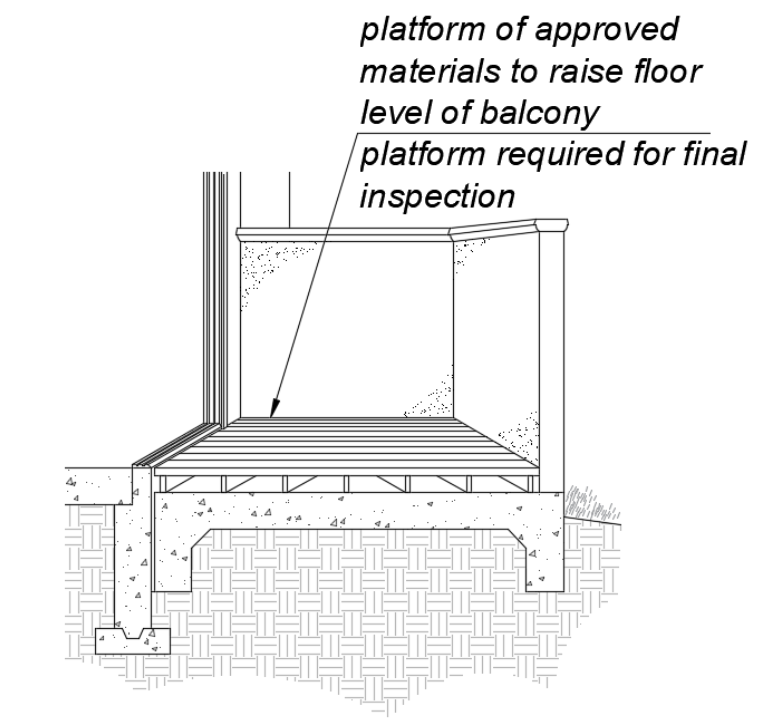
FIGURE 11B-809.8 Ex. 1(c)
PLATFORM AT SECONDARY EXTERIOR DOOR.
d. Secondary exterior doors onto decks, patios or balcony surfaces constructed of impervious materials (e.g., concrete, brick, flagstone) may have a maximum change in height from the interior landing of 1 inch (25 mm), provided a ramp with a maximum slope of 1:8 is permanently installed as illustrated in Figure 11B-809.8 (d).
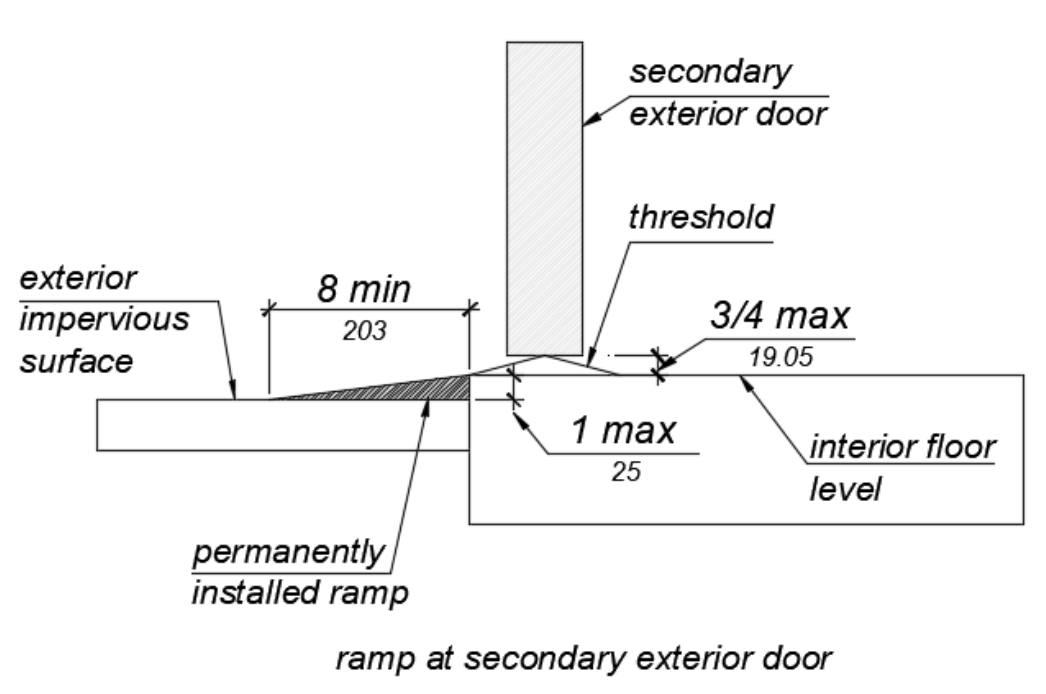
FIGURE 11B-809.8 Ex. 1(d)
RAMP AT SECONDARY EXTERIOR DOOR.
11B-809.8.1 Door Thresholds.
Secondary exterior door thresholds, including sliding door tracks, shall be 3/4 inch (19.1 mm) high maximum with a 1:2 maximum slope.
11B-809.8.2 Door opening force.
The opening force for primary entry exterior doors and secondary exterior doors shall be 8.5 pounds (38 N) maximum.
11B-809.8.3 Door maneuvering clearance.
-
At the dwelling unit side of the primary entry doors, secondary exterior doors, and required exit doors maneuvering clearances shall be 44 inches (1118 mm) minimum in length measured perpendicular to the face of the door in the closed position. The width of the maneuvering clearance shall extend 18 inches (457 mm) beyond the strike edge at the pull side of the door.
-
At interior doors maneuvering clearances shall be 42 inches (1067 mm) minimum in length on the both (sic) sides of the door measured perpendicular to the face of the door in the closed position. A 39 inch (991 mm) minimum length is allowed at interior doors when a clear opening width of 34 inches (864 mm) minimum is provided. The width of the maneuvering clearance shall extend 18 inches (457 mm) beyond the strike edge at the pull side of the door.
11B-809.8.4 Door signal devices.
Every primary entrance to a residential dwelling unit with adaptable features shall be provided with a door buzzer, bell, chime or equivalent. The activating mechanism shall be mounted 48 inches (1219 mm) maximum above the floor and connected to permanent wiring.
11B-809.9 Kitchens.
Kitchens shall be on an accessible route and shall comply with this section.
11B-809.9.1 Clear floor space.
Clear floor spaces 30 inches (762 mm) by 48 inches (1219 mm), with centerlines aligned with the centerline of the work surface, appliance, sink or fixture, shall be provided in the following locations:
-
For a parallel approach at the range.
-
For parallel or forward approach at a cooktop.
-
For a parallel or forward approach to the sink and to the work surface required by Sections 11B-809.9.3 and 11B-809.9.4.
-
For a parallel or forward approach to all other fixtures or appliances.
11B-809.9.2 Clear width.
Kitchens shall have a minimum clear width measured between any cabinet, work surface or the face of any appliance (excluding handles and controls) and the opposing cabinet, work surface, appliance or wall as follows:
a. U-shaped kitchens, designed with parallel approach at a sink, range, cooktop or other fixtures and appliances located at the base of the U without knee and toe clearance, shall provide a clear width of 60 inches (1524 mm) minimum.
b. U-shaped kitchens, with a cooktop, sink or work surface located at the base of the U, that provides knee and toe space complying Sections 11B-809.9.3 and 11B-809.9.4 to allow for a forward approach, shall provide a clear width of 48 inches (1219 mm) minimum.
c. All other kitchen designs shall provide a clear width of 48 inches (1219 mm) minimum.
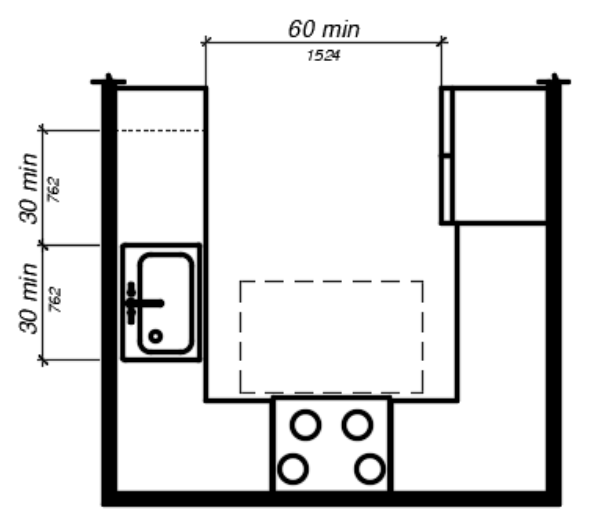
(a)
"U" shaped kitchen with parallel approach at range
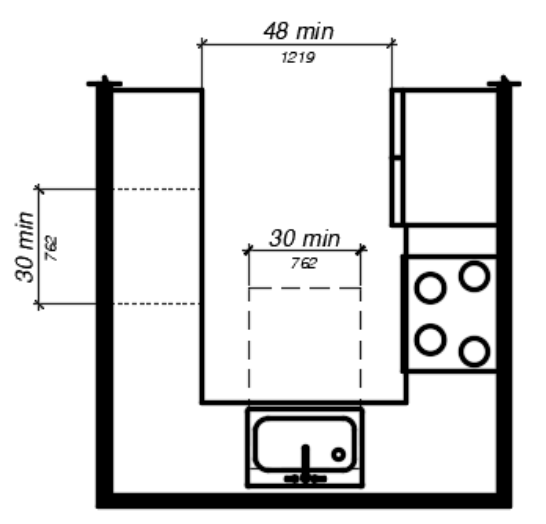
(b)
"U" shaped kitchen with forward approach at sink
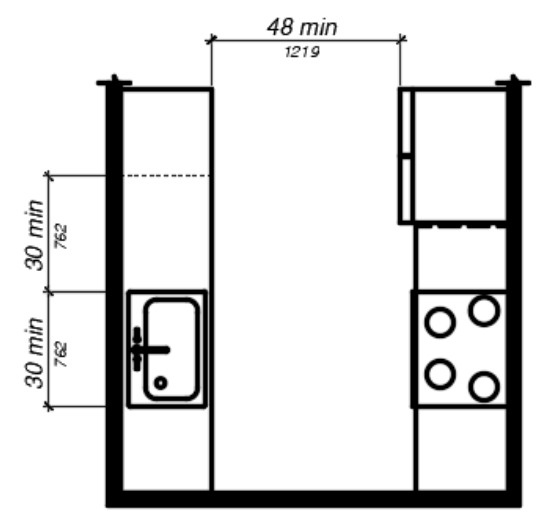
(c)
other kitchen designs
FIGURE 11B-809.9.2
CLEAR WIDTH AT KITCHENS.
11B-809.9.3 Removable base cabinets.
Knee and toe space complying with Section 11B-306 shall be provided at sinks and work surfaces required to comply with Section 11B-809.9.4.
Exception: Removable base cabinets shall be permitted under sinks and work surfaces provided that all of the following conditions are met:
a) base cabinets can be removed without the use of specialized tools or knowledge;
b) the finish floor extends under the base cabinet; and
c) the walls behind and surrounding the base cabinets are finished.
11B-809.9.4 Work surfaces.
Work surfaces shall be 36 inches (914 mm) maximum above the finish floor with minimum lengths at the following locations as required by this section:
-
Linear length of 30 inches (762 mm) minimum for installation of a sink.
-
Linear length of 30 inches (762 mm) minimum for work surfaces.
-
A sink and work surface in a single integral unit 60 inches (1524 mm) minimum in length, is permitted.
11B-809.9.5 Lower shelving.
Lower shelving and/or drawer space shall be provided at a height of 48 inches (1219 mm) maximum above the finish floor.
11B-809.9.6 Controls.
Controls for faucets shall comply with Section 11B-309.1. Hand-operated metering faucets shall remain open for 10 seconds minimum.
11B-809.9.7 Exposed pipes and surfaces.
Exposed water supply and drain pipes under sinks and lavatories shall comply with Section 11B-606.5.
11B-809.10.1 General.
All toilet and bathing rooms on an accessible route within residential dwelling units with adaptable features shall comply with Sections 11B-809.7, 11B-809.8, 11B-809.10.6.4, 11B-809.10.7.3 and 11B-809.12.
11B-809.10.2 Number of complying bathing rooms and fixtures.
One bathing room and one fixture of each type within the dwelling unit shall be designed to comply with the following:
-
Maneuvering space in toilet, bathing and shower rooms shall comply with Section 11B-809.10.4.
-
Bathtubs complying with Section 11B-809.10.5.
-
Showers complying with Section 11B-809.10.6.
-
Water closets complying with Section 11B-809.10.7.
-
Lavatories, vanities, mirrors and towel bars complying with Section 11B-809.10.8. When two or more lavatories are provided, at least one shall comply with Section 11B-809.10.8.
-
Where both a tub and shower are provided in the bathroom, at least one shall be made accessible. Where two or more bathrooms are provided, when a bathtub is installed in the first bathroom in compliance with Section 11B-809.10.5 and a shower compartment is provided in a subsequent bathroom, at least one shower compartment shall comply with Section 11B-809.10.6.
11B-809.10.3 Powder rooms.
Powder rooms shall be designed to comply with Sections 11B-809.7, 11B-809.8, 11B-809.10.5.2, 11B-809.10.6.4, 11B-809.10.7.3, and 11B-809.12. When the powder room is the only toilet facility located on an accessible level it shall, in addition, comply with Sections 11B-809.10.4, 11B-809.10.7 and 11B-809.10.8.
11B-809.10.4 Sufficient maneuvering space.
Where doors swing into the toilet and bathing or powder rooms required to comply with Section 11B-809.10, a clear maneuvering space of 30 (762 mm) inches by 48 inches (1219 mm) minimum shall be provided outside the arc of the door swing. The clear maneuvering space shall be permitted to include knee and toe clearance under bathroom fixtures. Doors shall be permitted to encroach into the clear floor space or clearance for fixtures where clear maneuvering space is provided outside the arc of the door swing. A turning space is not required within the room.
11B-809.10.5 Bathtubs.
Bathtubs required by Section 11B-809.10 shall comply with this section.
11B-809.10.5.1 Clear floor space.
A clear floor space 30 inches (762 mm) minimum by 48 inches (1219 mm) minimum shall be located with the long edge of the clear floor space parallel to the side of the bathtub or bathtub-shower combination. Controls shall be located on the wall at the foot of the bathtub. The edge of the clear floor space shall be flush with the control wall surface. The area under a lavatory, located at the control end of the tub, shall be permitted to encroach on the clear floor space provided the lavatory is 19 inches (483 mm) maximum in depth, and knee and toe clearance complying with Section 11B-306 is provided. Cabinets under lavatories and toilets shall not encroach on the clear floor space.
11B-809.10.5.2 Reinforcement for grab bars.
Reinforcement for grabs bars shall comply with the following:
1. Where bathtubs are installed without surrounding walls reinforcement shall be provided for floor-mounted grab bars.
2. Where bathtubs are installed with surrounding walls, grab bar reinforcement shall be installed as follows:
a. At the control end wall and head end wall, between 30 inches (762 mm) maximum to 38 inches (965 mm) minimum above the finish floor, extending 28 inches (711 mm) minimum from the front edge of the bathtub to the back wall of the bathtub. The grab bar reinforcement shall be 8 inches (203 mm) minimum in height.
b. At the back wall, from 5 inches (127 mm) maximum above the bathtub rim to 38 inches (965 mm) minimum above the finish floor. Grab bar backing shall be installed horizontally to permit the installation of a 48-inch (1219 mm) grab bar with each end 6 inches (152 mm) maximum from the end walls of the bathtub.
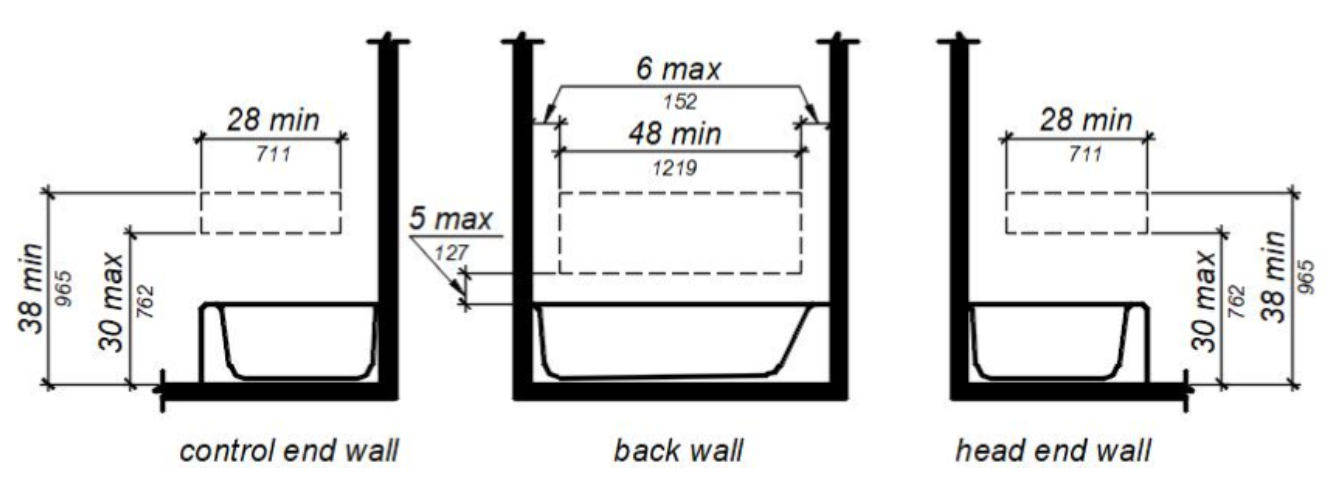
FIGURE 11B-809.10.5.2 REINFORCEMENT FOR GRAB BARS.
11B-809.10.5.3 Controls.
Controls and operating mechanisms shall comply with Section 11B-309.4.
Exception: Shower spray units are not required in bathtubs.
11B-809.10.5.4 Bathtub enclosures.
Doors and panels of bathtub enclosures shall be constructed from approved, shatter-resistant materials. Hinged doors shall open outward. Glazing used in doors and panels of bathtub enclosures shall be fully tempered, laminated safety glass or approved plastic. When glass is used, it shall be 1/8 inch (3.2 mm) thick minimum when fully tempered, or 1/4 inch (6.4 mm) thick minimum when laminated, and shall pass the test requirements of this part, Chapter 24 Glass and Glazing. Plastics used in doors and panels of bathtub enclosures shall be of a shatter-resistant type.
11B-809.10.6 Showers.
Showers required by Section 11B-809.10 shall comply with this section.
11B-809.10.6.1 Size.
When one or more shower stalls are provided within the same dwelling unit, as least one shower stall shall comply with one of the following:
-
A transfer type shower compartment 36 inches (914 mm) wide by 36 inches (914 mm) deep with an entrance opening 36 inches (914 mm) complying with Section 11B-608.1 or;
-
A shower stall 30 inches (762 mm) deep minimum by 60 inches (1524 mm) wide minimum with an entrance opening 60 inches (1524 mm) minimum. A water closet shall be permitted to project 12 inches (305 mm) maximum into the opening provided that 36 inches (914 mm) minimum clear space is maintained between the water closet and the shower wall as illustrated in Figure 11B-809.10.6.1 or;
-
A shower stall 36 inches (914 mm) deep by 60 inches (1524 mm) wide minimum with an entrance 36 inches (914 mm) minimum when a wall is installed on the opening side.
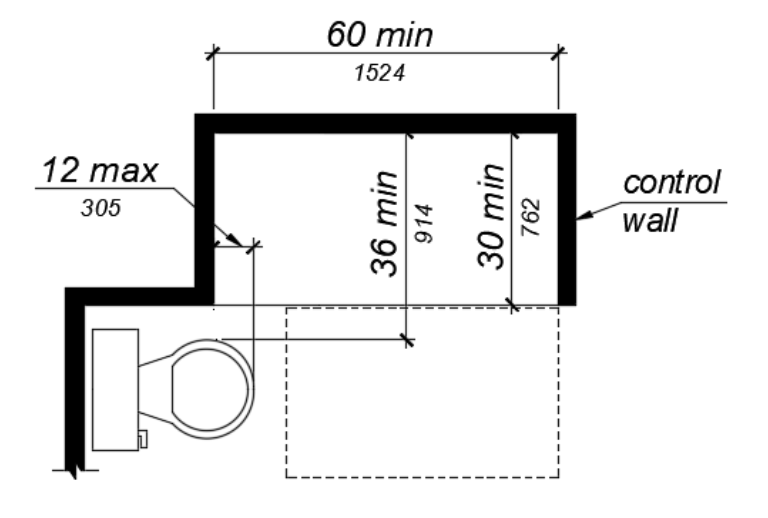
FIGURE 11B-809.10.6.1 SHOWERS.
11B-809.10.6.2 Slope.
The slope of the shower floor shall be 1/2 inch (12.7 mm) per foot maximum in any direction and shall slope to a drain. The floor surfaces shall be of Carborundum, grit-faced tile or of material providing equivalent slip resistance.
11B-809.10.6.3 Floor space.
A clear maneuvering space 30 inches (762 mm) wide minimum by 48 inches (1219 mm) minimum in length shall be located outside the shower, with the width flush with the control wall and the length parallel to the length of the shower.
11B-809.10.6.4 Reinforcement for grab bars.
Reinforcement for grabs bars shall comply with the following: Continuous reinforcement shall be installed in the walls of showers 30 inches (762 mm) maximum to 38 inches (965 mm) minimum above the finish floor. The grab bar reinforcement shall be 8 inches (203 mm) minimum in height. Glass-walled shower stalls shall provide reinforcement for installation of floor-mounted or ceiling-mounted grab bars.
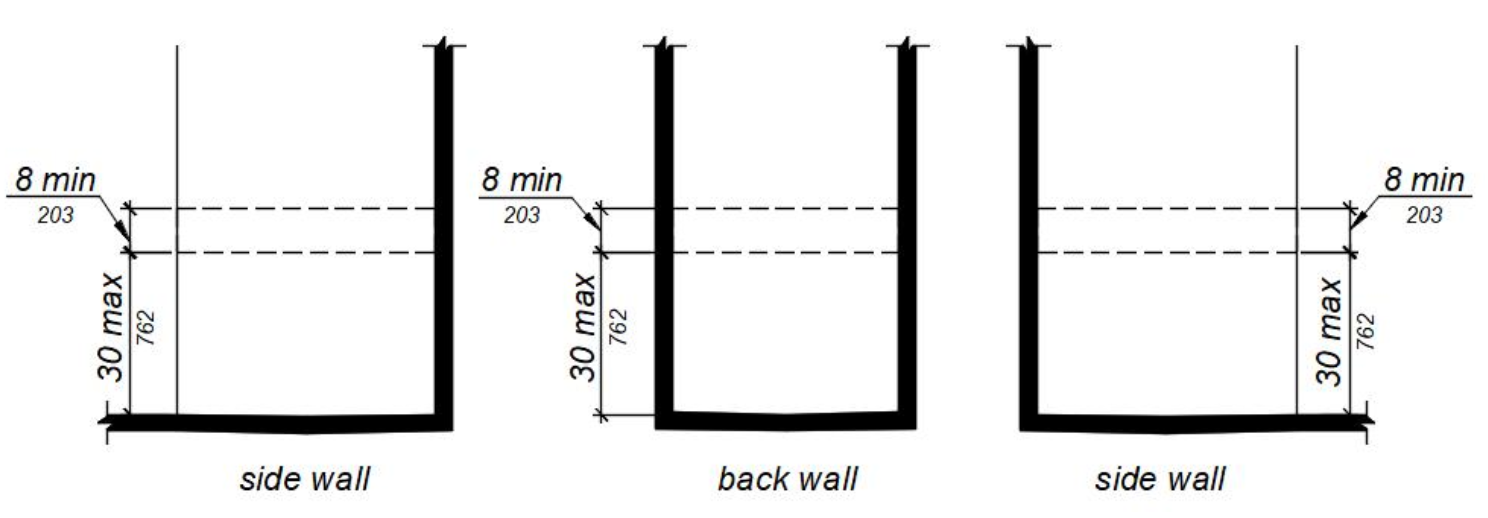
FIGURE 11B-809.10.6.4 REINFORCEMENT FOR GRAB BARS.
11B-809.10.6.5 Thresholds.
Where provided thresholds shall be 2 inches (51 mm) maximum in height and have a beveled or sloped angle not exceeding 1 unit vertical in 2 units horizontal (26.6 degrees from the horizontal). Thresholds 1/2 inch (12.7 mm) or less in height shall have a beveled or sloped angle not exceeding 1 unit vertical in 1 unit horizontal (45 degrees from the horizontal).
11B-809.10.6.6 Controls.
Controls and operating mechanisms shall comply with Section 11B-309.4.
11B-809.10.6.7 Shower enclosures.
Doors and panels of shower enclosures shall comply with Section 11B-809.10.5.4.
11B-809.10.7 Water closets.
Water closets required by Section 11B-809.10 shall comply with this section.
11B-809.10.7.1 Floor space.
The floor space at water closets shall be 48 inches (1219 mm) wide minimum measured perpendicular to the side wall. A floor space 48 inches (1219 mm) wide minimum by 36 inches (914 mm) deep minimum shall be provided in front of the water closet.
Exception: The 48-inch (1219 mm) minimum clear width may be reduced to 36 inches (914 mm) minimum for lavatories, cabinets, wing walls, or privacy walls located immediately adjacent to a water closet which extend 24 inches (610 mm) maximum in depth.
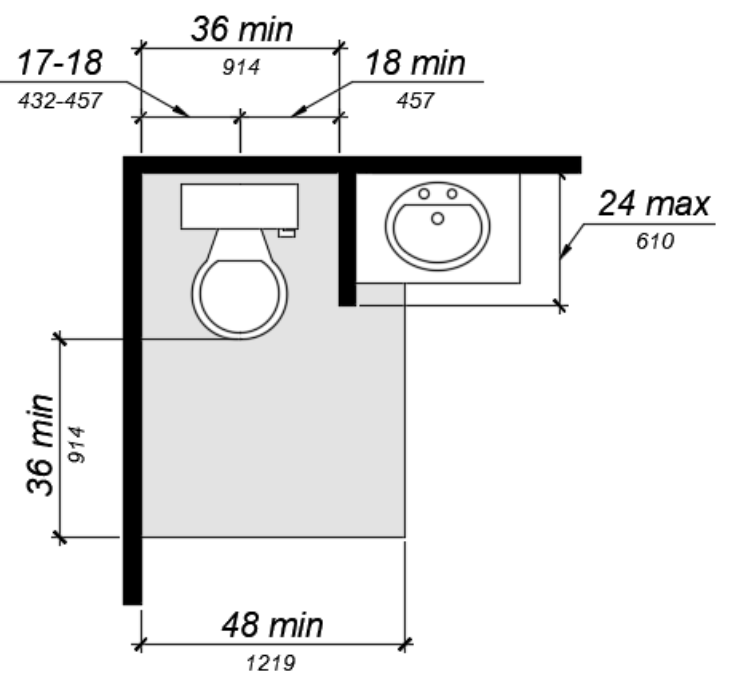
FIGURE 11B-809.10.7.1 FLOOR SPACE.
11B-809.10.7.2 Location.
Water closets shall be located within bathrooms in a manner that permits a grab bar to be installed on at least one side of the fixture. The centerline of the water closet shall be 17 inches (432 mm) minimum to 18 inches (457 mm) maximum from a wall or partition that is 54 inches (1372 mm) minimum in length. In locations where water closets are adjacent to other walls, vanities, lavatories or bathtubs, the centerline of the fixture shall be 18 inches (457 mm) minimum from the obstacle.
11B-809.10.7.3 Reinforcement for grab bars.
Reinforcement for grabs bars shall comply with the following:
-
Where water closets are not placed adjacent to a side wall capable of accommodating a grab bar, the bathroom shall have provisions for installation of floor-mounted, foldaway or similar alternative grab bars.
-
Where water closets are placed adjacent to a side wall, reinforcement shall be installed on both sides or one side and the back. Where reinforcement is installed at the back, it shall be installed between 30 inches (762 mm) maximum and 38 inches (965 mm) minimum above the finish floor. The grab bar reinforcement shall be 8 inches (203 mm) minimum in height. The backing shall 40 (sic) inches (1016 mm) minimum in length.
-
Where the water closet is located adjacent to lavatories, cabinets, wing walls, or privacy walls the grab bar reinforcement shall be 36 inches (914 mm) in length. Reinforcement installed at the side wall of the water closet shall be between 30 inches (762 mm) minimum to 38 inches (965 mm) maximum above the finish floor. The reinforcement shall be 10 inches (254 mm) maximum from the rear wall and shall extend 30 inches (762 mm) minimum in front of the water closet. The grab bar reinforcement shall be 8 inches (203 mm) minimum in height.
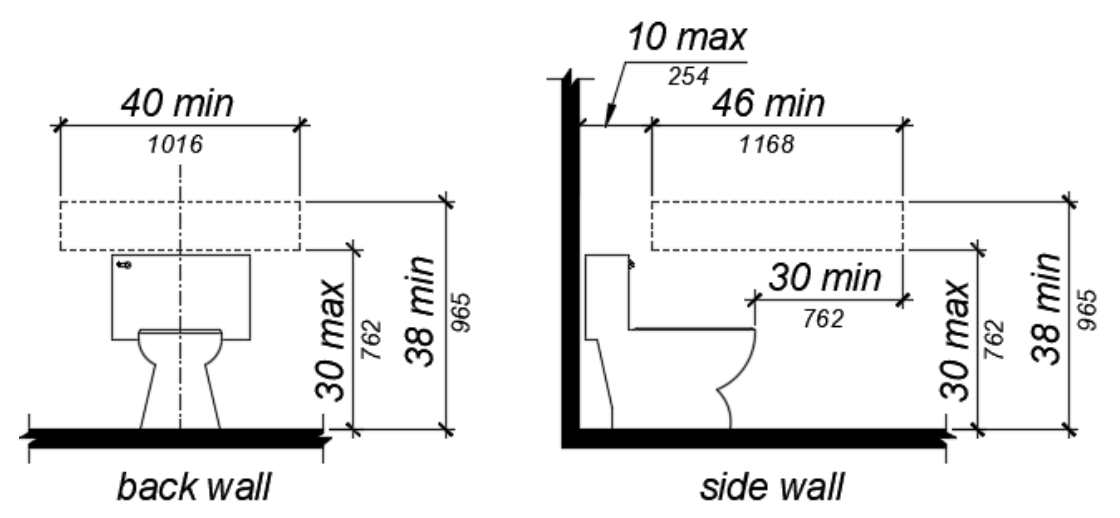
FIGURE 11B-809.10.7.3 REINFORCEMENT FOR GRAB BARS.
11B-809.10.7.4 Seat height.
Water closet seats shall be 15 inches (381 mm) minimum and 19 inches (483 mm) maximum measured to the top of the seat above the finish floor.
11B-809.10.7.5 Controls.
Controls shall be mounted 44 inches (1118 mm) maximum above the finish floor. The force required to activate controls shall be 5 pounds (22.2 mm) maximum.
11B-809.10.8 Lavatories, vanities, mirrors and towel bars.
Bathing rooms or powder rooms required to comply with Section 11B-809.10 shall provide lavatories complying with this section. Where mirrors or towel bars are provided, no less than one of each shall comply with this section.
11B-809.10.8.1 Location.
Lavatories without base cabinets shall be installed with the centerline 18 inches (457 mm) minimum from an adjoining wall or fixture to allow for forward approach. Lavatories with base cabinets shall be installed with the centerline 24 inches (610 mm) minimum from an adjoining wall or fixture to allow for a parallel approach. The top of the lavatory rim shall be 34 inches (864 mm) maximum above the finished floor.
11B-809.10.8.2 Floor space.
A floor space 30 inches (762 mm) minimum by 48 inches (1219 mm) minimum shall be provided centered on the lavatory.
11B-809.10.8.3 Cabinets.
Cabinets shall be removable without the use of specialized knowledge and/or tools. The finished floor shall extend to the wall under the lavatory.
11B-809.10.8.4 Knee and toe clearance.
Knee and toe clearance shall be provided and comply with Section 11B-306.
11B-809.10.8.5 Plumbing protection.
Plumbing protection shall comply with Section 11B-809.9.7.
11B-809.10.8.6 Controls.
Faucet controls and operating mechanisms shall comply with Section 11B-309.4.
11B-809.10.8.7 Mirrors and towel bars.
Where mirrors are provided the bottom edge of the reflective surface shall be 40 inches (1016 mm) maximum above the finish floor. Where towel bars are provided they shall be installed 40 inches (1016 mm) maximum above the finish floor to the top of the bar.
11B-809.11 Washing machines and clothes dryers.
Where washing machines and clothes dryers are provided in residential dwelling units with adaptable features, one of each type shall be provided.
11B-809.12 Electrical receptacles, controls and switches.
Electrical receptacles on branch circuits of 30 amperes or less, communication system receptacles, controls and switches shall be located as follows:
-
Where there is no obstruction, 48 inches (1219 mm) maximum measured from the top of the receptacle box and 15 inches (381 mm) minimum measured from the bottom of the receptacle box to the finish floor.
-
Where the reach is over an obstruction, electrical receptacles, controls and switches shall comply with Sections 11B-309.2 and 11B-308.3.
-
When the reach is over a kitchen work surface and base cabinet, the work surface shall be 36 inches (914 mm) maximum above the finish floor and 25 1/2 inches (650 mm) maximum in depth. The base cabinet shall be 24 inches (610 mm) maximum in depth.
-
Where receptacles are provided in a kitchen at a corner work surface, one receptacle shall be located 36 inches (915 mm) from either wall at the inside corner.
Exceptions:
a. Electrical receptacles installed as part of permanently installed baseboard heaters.
b. Electrical receptacles in floors adjacent to sliding panels or walls.
c. Baseboard electrical receptacles in relocatable partitions, window walls or other electrical convenience floor outlets.
d. Appliances (e.g., stoves, dishwashers, range hoods, microwave ovens and similar appliances) which have controls located on the appliance.
e. Electrical receptacles dedicated to specific appliances.
f. Circuit breakers.
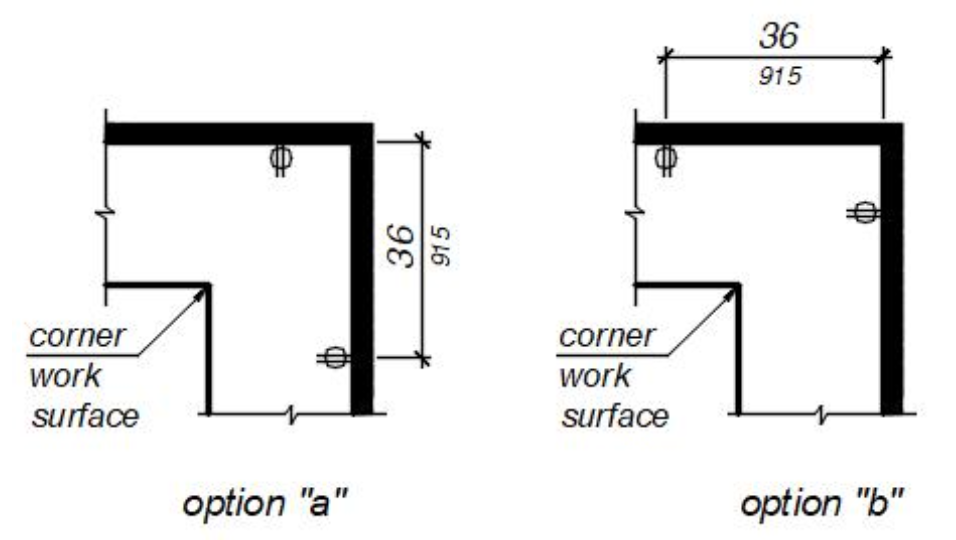
FIGURE 11B-809.12
ELECTRICAL RECEPTACLES AT CORNER WORKSURFACES
11B-810.1 General.
Transportation facilities shall comply with Section 11B-810.
11B-810.1.1 Vehicle boarding.
Stations shall not be designed or constructed so as to require persons with disabilities to board or alight from a vehicle at a location other than one used by the general public.
11B-810.1.2 Baggage systems.
Baggage check-in and retrieval systems shall be on an accessible route complying with Section 11B-402 and shall have space immediately adjacent complying with Section 11B-302.
11B-810.2 Bus boarding and alighting areas.
Bus boarding and alighting areas shall comply with Section 11B-810.2.

11B-810.2.1 Surface.
Bus stop boarding and alighting areas shall have a firm, stable surface.
11B-810.2.2 Dimensions.
Bus stop boarding and alighting areas shall provide a clear length of 96 inches (2438 mm) minimum, measured perpendicular to the curb or vehicle roadway edge, and a clear width of 60 inches (1524 mm) minimum, measured parallel to the vehicle roadway.
U.S. Access Board's Note to Reader:
The Department of Transportation's ADA Standards indicate that compliance is required to the extent construction specifications are within a public entity's control:
[ADA Title II - Public Transportation] 810.2.2 Dimensions. Bus boarding and alighting areas shall provide a clear length of 96 inches (2440 mm), measured perpendicular to the curb or vehicle roadway edge, and a clear width of 60 inches (1525 mm), measured parallel to the vehicle roadway. Public entities shall ensure that the construction of bus boarding and alighting areas comply with 810.2.2, to the extent the construction specifications are within their control.
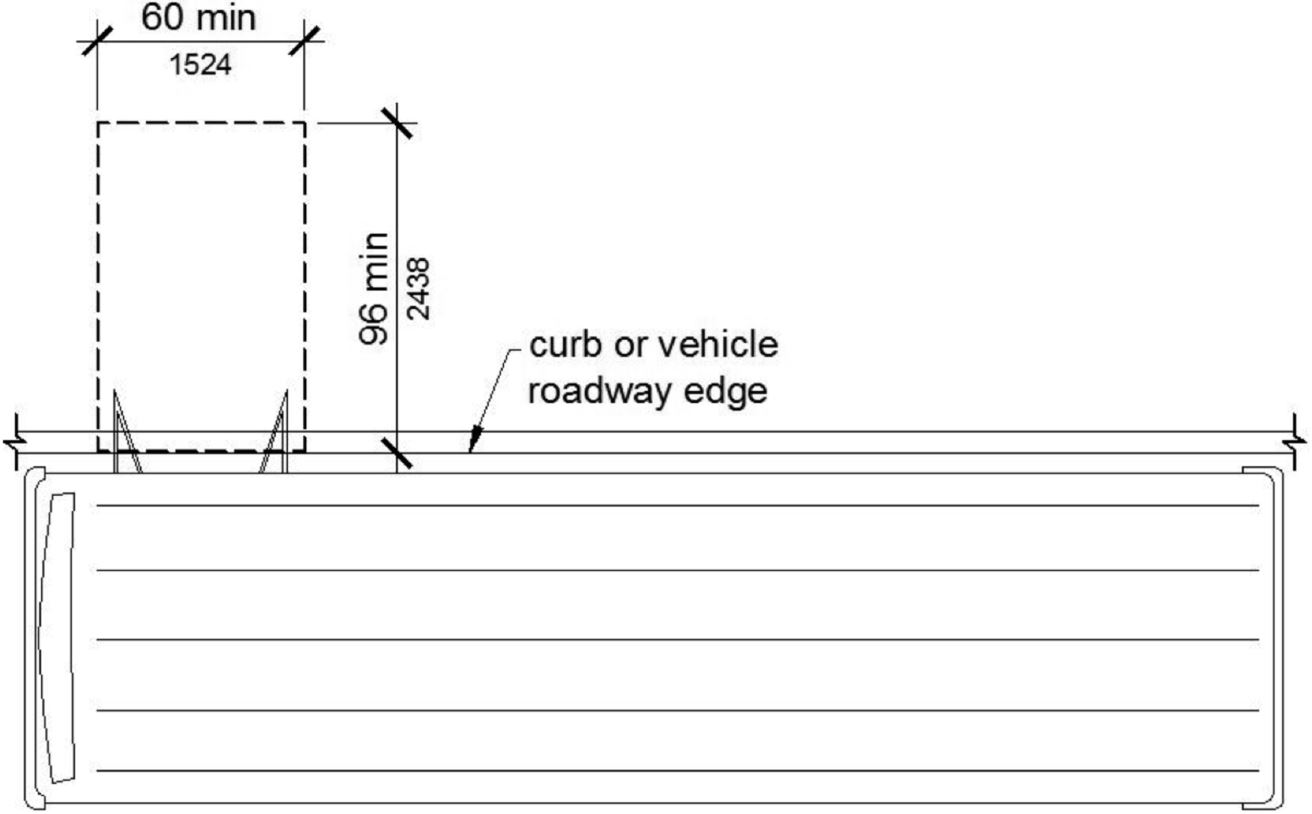
FIGURE 11B-810.2.2 DIMENSIONS OF BUS BOARDING AND ALIGHTING AREAS
11B-810.2.3 Connection.
Bus stop boarding and alighting areas shall be connected to streets, sidewalks, or pedestrian paths by an accessible route complying with Section 11B-402. Newly constructed bus stop boarding and alighting areas shall provide a detectable transition between the boarding/alighting area and the roadway; the detectable transition shall consist of a curb with the face sloped at 35 degrees maximum from vertical or detectable warnings complying with Sections 11B-705.1.1 and 11B-705.1.2.4.
[2010 ADA Standards] 810.2.3 Connection. Bus stop boarding and alighting areas shall be connected to streets, sidewalks, or pedestrian paths by an accessible route complying with 402.
11B-810.2.4 Slope.
Parallel to the roadway, the slope of the bus stop boarding and alighting area shall be the same as the roadway, to the maximum extent practicable. Perpendicular to the roadway, the slope of the bus stop boarding and alighting area shall not be steeper than 1:48.
11B-810.3 Bus shelters.
Bus shelters shall provide a minimum clear floor or ground space complying with Section 11B-305 entirely within the shelter. Bus shelters shall be connected by an accessible route complying with Section 11B-402 to a boarding and alighting area complying with Section 11B-810.2.
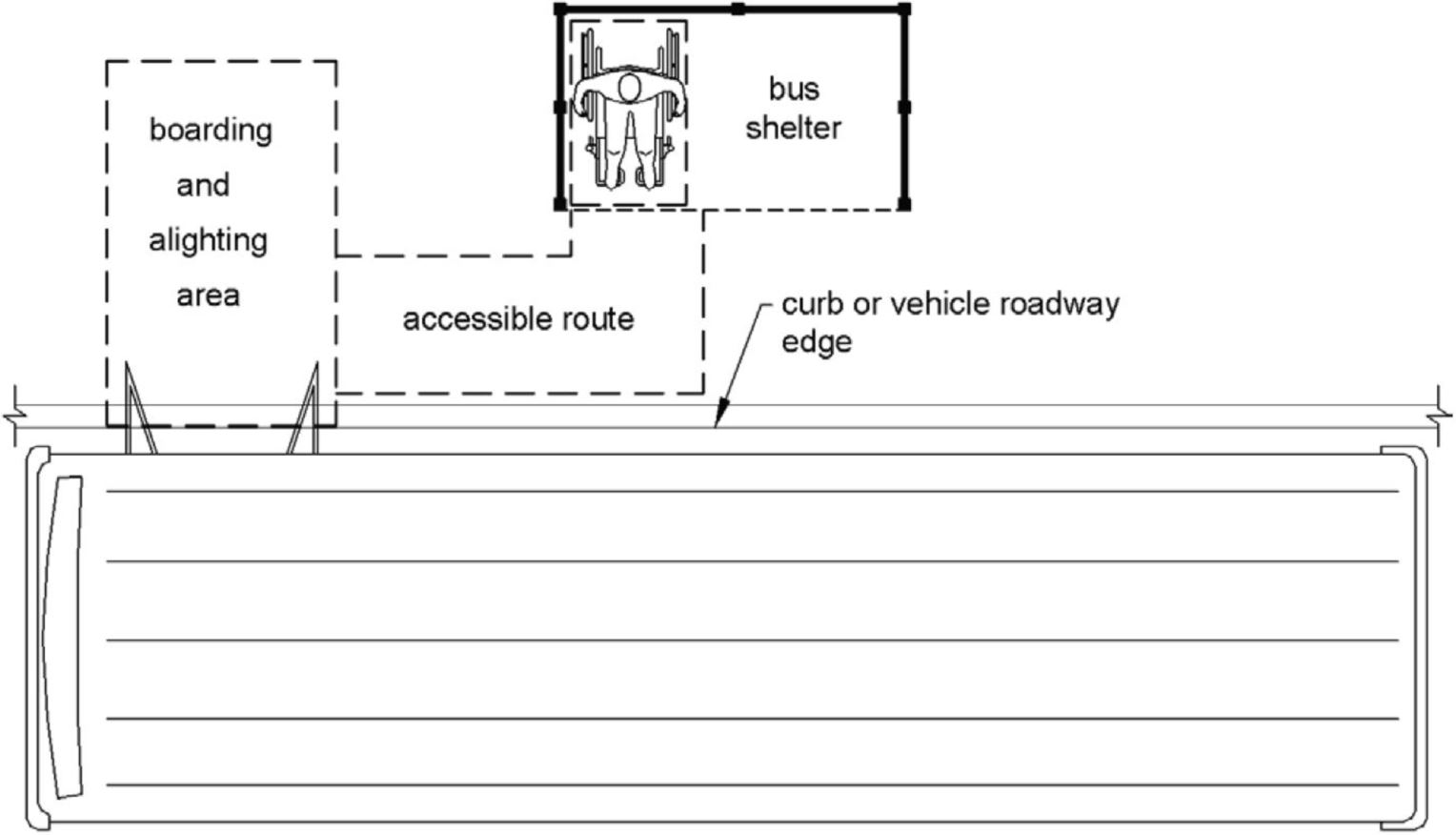
FIGURE 11B-810.3 BUS SHELTERS
11B-810.4 Bus signs.
Bus route identification signs shall comply with Sections 11B-703.5.1 through 11B-703.5.4, and Sections 11B-703.5.7 and 11B-703.5.8. In addition, to the maximum extent practicable, bus route identification signs shall comply with Section 11B-703.5.5.
Exception: Bus schedules, timetables and maps that are posted at the bus stop or bus bay shall not be required to comply.
11B-810.5 Rail Platforms.
Rail platforms shall comply with Section 11B-810.5.
11B-810.5.1 Slope.
Rail platforms shall not exceed a slope of 1:48 in all directions.
Exception: Where platforms serve vehicles operating on existing track or track laid in existing roadway, the slope of the platform parallel to the track shall be permitted to be equal to the slope (grade) of the roadway or existing track.
11B-810.5.2 Detectable warnings.
Platform boarding edges not protected by platform screens or guards shall have detectable warnings complying with Section 11B-705 along the full length of the public use area of the platform.
11B-810.5.3 Platform and vehicle floor coordination.
Station platforms shall be positioned to coordinate with vehicles in accordance with the applicable requirements of 36 CFR Part 1192. Low-level platforms shall be 8 inches (203 mm) minimum above top of rail.
Exception: Where vehicles are boarded from sidewalks or street-level, low-level platforms shall be permitted to be less than 8 inches (203 mm).
U.S. Access Board's Note to Reader:
The Department of Transportation's ADA Standards note permitted alternatives where compliance is not operationally or structurally feasible in light rail, commuter rail, or intercity rail systems:
[ADA Title II - Public Transportation] 810.5.3 Platform and Vehicle Floor Coordination. Station platforms shall be positioned to coordinate with vehicles in accordance with the applicable requirements of 36 CFR part 1192. Low-level platforms shall be 8 inches (205 mm) minimum above top of rail. In light rail, commuter rail, and intercity rail systems where it is not operationally or structurally feasible to meet the horizontal gap or vertical difference requirements of part 1192 or 49 CFR part 38, mini-high platforms, car-borne or platform-mounted lifts, ramps or bridge plates or similarly manually deployed devices, meeting the requirements of 49 CFR part 38, shall suffice.
EXCEPTION: Where vehicles are boarded from sidewalks or street-level, low-level platforms shall be permitted to be less than 8 inches (205 mm).

11B-810.6 Rail station signs.
Rail station signs shall comply with Section 11B-810.6.
Exception: Signs shall not be required to comply with Sections 11B-810.6.1 and 11B-810.6.2 where audible signs are remotely transmitted to hand-held receivers, or are user or proximity-actuated.

11B-810.6.1 Entrances.
Where signs identify a station or its entrance, at least one sign at each entrance shall comply with Section 11B-703.2 and shall be placed in uniform locations to the maximum extent practicable. Where signs identify a station that has no defined entrance, at least one sign shall comply with Section 11B-703.2 and shall be placed in a central location.
11B-810.6.2 Routes and destinations.
Lists of stations, routes and destinations served by the station which are located on boarding areas, platforms, or mezzanines shall comply with Section 11B-703.5. At least one tactile sign identifying the specific station and complying with Section 11B-703.2 shall be provided on each platform or boarding area. Signs covered by this requirement shall, to the maximum extent practicable, be placed in uniform locations within the system.
Exception: Where sign space is limited, characters shall not be required to exceed 3 inches (76 mm).

11B-810.6.3 Station names.
Stations covered by this section shall have identification signs complying with Section 11B-703.5. Signs shall be clearly visible and within the sight lines of standing and sitting passengers from within the vehicle on both sides when not obstructed by another vehicle.

11B-810.7 Public address systems.
Where public address systems convey audible information to the public, the same or equivalent information shall be provided in a visual format.
11B-810.8 Clocks.
Where clocks are provided for use by the public, the clock face shall be uncluttered so that its elements are clearly visible. Hands, numerals and digits shall contrast with the background either light-on-dark or dark-on-light. Where clocks are installed overhead, numerals and digits shall comply with Section 11B-703.5.
11B-810.9 Escalators.
Where provided, escalators shall comply with the sections 6.1.3.5.6 and 6.1.3.6.5 of ASME A17.1 and shall have a clear width of 32 inches (813 mm) minimum.
Exception: Existing escalators in key stations shall not be required to comply with Section 11B-810.9.
11B-810.10 Track crossings.
Where a circulation path serving boarding platforms crosses tracks, it shall comply with Section 11B-402.
Exception: Openings for wheel flanges shall be permitted to be 2½ inches (64 mm) maximum.

FIGURE 11B-810.10 (EXCEPTION) TRACK CROSSINGS
11B-811.1 General.
Storage shall comply with Section 11B-811.
11B-811.2 Clear floor or ground space.
A clear floor or ground space complying with Section 11B-305 shall be provided.
11B-811.3 Height.
Storage elements shall comply with at least one of the reach ranges specified in Section 11B-308.
11B-811.4 Operable parts.
Operable parts shall comply with Section 11B-309.
11B-812 Electric vehicle charging stations
ETA Editor's Note
EVCS are not addressed by 2010 ADA Standards, although a case could be made, based on the general obligation for governments to make their services, programs or activities available to individuals with disabilities [ADA Title II §35.130], and for public accommodations and commercial facilities to make their goods, services, facilities, etc. available [ADA Title III §36.201(a)], that, if EVCS are made available to the public by any of these entities, they must be made available to individuals with disabilities. However, the absence of scoping or technical requirements in the Standards would make it difficult to conclude what that means.
11B-812.1 General.
Electric vehicle charging stations (EVCS) shall comply with Section 11B-812 as required by Section 11B-228.3. Where vehicle spaces and access aisles are marked with lines, measurements shall be made from the centerline of the markings.
Exception: Where vehicle spaces or access aisles are not adjacent to another vehicle space, access aisle, or parking space, measurements shall be permitted to include the full width of the line defining the vehicle space or access aisle.
11B-812.3 Floor or ground surfaces.
Vehicle spaces and access aisles serving them shall comply with Section 11B-302. Access aisles shall be at the same level as the vehicle space they serve. Changes in level, slopes exceeding 1:48, and detectable warnings shall not be permitted.
11B-812.4 Vertical clearance.
Vehicle spaces, access aisles serving them, and vehicular routes serving them shall provide a vertical clearance of 98 inches (2489 mm) minimum. Where provided, overhead cable management systems shall not obstruct required vertical clearance.
11B-812.5.1 Accessible route to building or facility.
EVCS complying with Section 11B-812 that serve a particular building or facility shall be located on an accessible route to an entrance complying with Section 11B-206.4. Where EVCS do not serve a particular building or facility, EVCS complying with Section 11B-812 shall be located on an accessible route to an accessible pedestrian entrance of the EV charging facility.
Exception: EVCS complying with Section 11B-812 shall be permitted to be located in different EV charging facilities if substantially equivalent or greater accessibility is provided in terms of distance from an accessible entrance or entrances, charging fee, and user convenience.
11B-812.5.2 Accessible route to EV charger.
An accessible route complying with Section 11B-402 shall be provided between the vehicle space and the EV charger which serves it.
11B-812.5.3 Relationship to accessible routes.
Vehicle spaces and access aisles shall be designed so that when the vehicle space is occupied the required clear width of adjacent accessible routes is not obstructed. A curb, wheel stop, bollards, or other barrier shall be provided if required to prevent encroachment of vehicles over the required clear width of adjacent accessible routes.
11B-812.5.4 Arrangement.
Vehicle spaces and access aisles shall be designed so that persons using them are not required to travel behind vehicle spaces or parking spaces other than the vehicle space in which their vehicle has been left to charge.
Exceptions:
- Ambulatory EVCS shall not be required to comply with Section 11B-812.5.4.
- Vehicle spaces installed in existing facilities shall comply with Section 11B-812.5.4 to the maximum extent feasible.
11B-812.5.5 Obstructions.
EVCS shall be designed so accessible routes are not obstructed by cables or other elements.
11B-812.6 Vehicle spaces.
Vehicle spaces serving van accessible, standard accessible, ambulatory and drive-up EVCS shall be 216 inches (5486 mm) long minimum and shall comply with Sections 11B-812.6.1 through 11B-812.6.4 as applicable. All vehicle spaces shall be marked to define their width.
Exceptions:
- Where the long dimension of vehicle spaces is parallel to the traffic flow in the adjacent vehicular way, the length of vehicle spaces shall be 240 inches (6096 mm) minimum.
- Vehicle spaces at drive-up EVCS shall be 240 inches (6096 mm) long minimum and shall not be required to be marked to define their width.
11B-812.6.1 Van accessible.
Vehicle spaces serving van accessible EVCS shall be 144 inches (3658 mm) wide minimum and shall have an adjacent access aisle complying with Section 11B-812.7.
11B-812.6.2 Standard accessible.
Vehicle spaces serving standard accessible EVCS shall be 108 inches (2743 mm) wide minimum and shall have an adjacent access aisle complying with Section 11B-812.7.
11B-812.6.3 Ambulatory.
Vehicle spaces serving ambulatory EVCS shall be 120 inches (3048 mm) wide minimum and shall not be required to have an adjacent access aisle.
11B-812.6.4 Drive-up.
Vehicle spaces serving drive-up EVCS shall be 204 inches (5182 mm) wide minimum and shall not be required to have an adjacent access aisle.
11B-812.7 Access aisle.
Access aisles shall adjoin an accessible route. Two vehicle spaces or one parking space and one electric vehicle charging space shall be permitted to share a common access aisle. Access aisles shall be 60 inches (1524 mm) wide minimum and shall extend the full required length of the vehicle spaces they serve.
11B-812.7.1 Location.
Access aisles at vehicle spaces shall not overlap the vehicular way and may be placed on either side of the vehicle space they serve except for van accessible spaces which shall have access aisles located on the passenger side of the vehicle spaces.
Exception: Where four or fewer total EVCS are provided within a facility, the access aisle for non-angled van accessible spaces may be located on either the driver or passenger side of the vehicle space.
11B-812.7.2 Marking.
Access aisles at vehicle spaces shall be marked with a painted borderline around their perimeter. The area within the borderlines shall be marked with hatched lines a maximum of 36 inches (914 mm) on center. The color of the borderlines, hatched lines, and letters shall contrast with that of the surface of the access aisle. The blue color required for identification of access aisles for accessible parking shall not be used. Access aisle markings may extend beyond the minimum required length.
Exception: Where one parking space and one electric vehicle charging space share an access aisle, access aisle marking shall comply with Section 11B-502.3.3 and shall not be required to comply with Section 11B-812.7.2.
11B-812.7.3 Lettering.
The words “NO PARKING” shall be painted on the surface within each access aisle in letters a minimum of 12 inches (305 mm) in height and located to be visible from the adjacent vehicular way.
11B-812.8 Identification signs.
EVCS identification signs shall be provided in compliance with Section 11B-812.8.
11B-812.8.1 Four or fewer.
Where four or fewer total EVCS are provided, identification with an International Symbol of Accessibility (ISA) shall not be required.
11B-812.8.2 Five to twenty-five.
Where five to twenty-five total EVCS are provided, one van accessible EVCS shall be identified by an ISA complying with Section 11B-703.7.2.1. The required standard accessible EVCS shall not be required to be identified with an ISA.
11B-812.8.3 Twenty-six or more.
Where twenty-six or more total EVCS are provided, all required van accessible and all required standard accessible EVCS shall be identified by an ISA complying with Section 11B-703.7.2.1.
11B-812.8.4 Ambulatory.
Ambulatory EVCS shall not be required to be identified by an ISA.
11B-812.8.5 Drive-up.
Drive-up EVCS shall not be required to be identified by an ISA.
11B-812.8.6 Finish and size.
Identification signs shall be reflectorized with a minimum area of 70 square inches (45161 mm2).
11B-812.8.7 Location.
Required identification signs shall be visible from the EVCS it serves. Signs shall be permanently posted either immediately adjacent to the vehicle space or within the projected vehicle space width at the head end of the vehicle space. Signs identifying van accessible vehicle spaces shall contain the designation “van accessible.” Signs shall be 60 inches (1525 mm) minimum above the finish floor or ground surface measured to the bottom of the sign. Signs located within a circulation path shall be 80 inches (2032 mm) minimum above the finish floor or ground surface measured to the bottom of the sign. Signs may also be permanently posted on a wall at the interior end of the vehicle space.
11B-812.9 Surface marking.
EVCS vehicle spaces shall provide surface marking stating “EV CHARGING ONLY” in letters 12 inches (305 mm) high minimum. The centerline of the text shall be a maximum of 6 inches (152 mm) from the centerline of the vehicle space and its lower corner at, or lower side aligned with, the end of the vehicle space length.
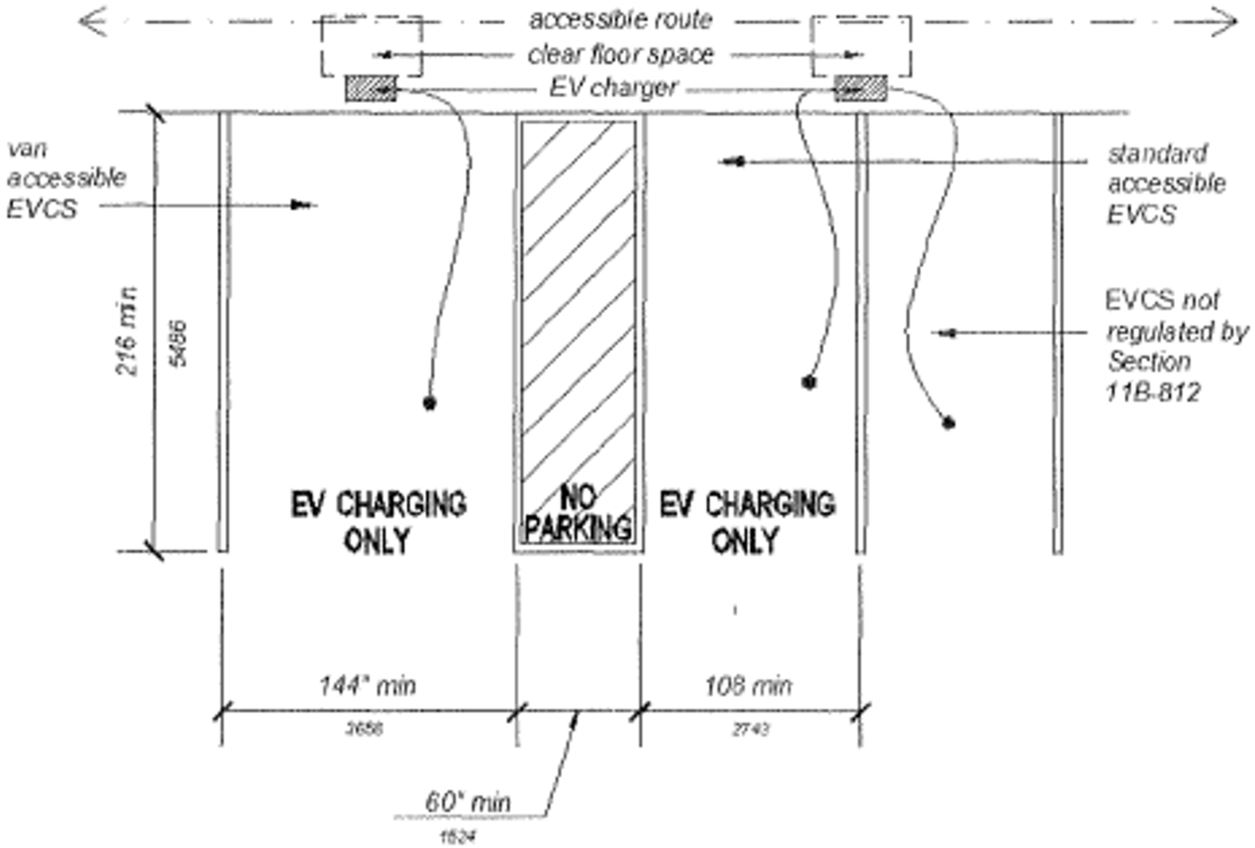
FIGURE 11B-812.9 SURFACE MARKING
11B-812.10.2 Operable parts.
Operable parts and charging cord storage shall comply with Section 11B-309.
11B-812.10.3 Point-of-sale devices.
Where provided, point-of-sale devices shall comply with Sections 11B-707.2, 11B-707.3, 11B-707.7.2, and 11B-707.9.
11B-812.10.4 Location.
EV chargers shall be adjacent to, and within the projected width of, the vehicle space being served.
Exceptions:
- EV chargers serving more than one EVCS shall be adjacent to, and within the combined projected width of, the vehicle spaces being served.
- For alterations at existing facilities where an accessible route or general circulation path is not provided adjacent to the head end of the vehicle space or access aisle, the EV charger may be located within the projected width of the access aisle 36 inches (914 mm) maximum from the head end of the space.
- Where the long dimension of a vehicle space is parallel to the vehicular way, the EV charger shall be adjacent to, and 48 inches (1219 mm) maximum from the head end or foot end of the vehicle space or access aisle being served.
11B-813 Adult changing facilities.
Adult changing facilities shall comply with Section 11B-813.
ETA Editor's Note
Adult changing facilities are not addressed by 2010 ADA Standards, although a case could be made, based on the general obligation for governments to make their services, programs or activities available to individuals with disabilities [ADA Title II §35.130], and for public accommodations and commercial facilities to make their goods, services, facilities, etc. available [ADA Title III §36.201(a)], that, if adult changing facilities are made available to the public by any of these entities, they must be made available to individuals with disabilities. However, the absence of scoping or technical requirements in the Standards would make it difficult to conclude what that means.
11B-813.1 Location.
Adult changing facilities shall be provided within a unisex (single-user or family) toilet room or other similar private room.
11B-813.2 Features.
Adult changing facilities shall provide features in compliance with Section 11B-813.2.
11B-813.2.1 Adult changing table.
Adult changing tables shall be fixed to the floor or a wall and shall comply with Section 11B-813.2.1.
11B-813.2.1.1 Size.
Adult changing tables shall have a changing surface of 70 inches (1778 mm) minimum length and 30 inches (762 mm) minimum width.
11B-813.2.1.2 Clearance.
A 36 inches minimum (914 mm) width side clearance shall be provided along the entire length of one side of adult changing tables. At both ends of adult changing tables, clearance shall be provided measuring 36 inches (914 mm) minimum wide and a minimum length as long as the table width plus the width of the side clearance. End and side clearances shall be measured from the outermost extent of the table. Floor or ground surfaces of clearances shall comply with Section 11B-302. Changes in level are not permitted.
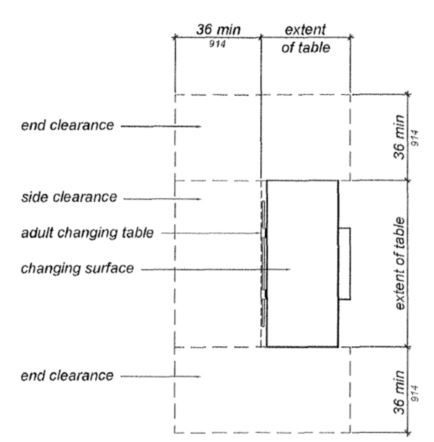
FIGURE 11B-813.2.1.2 CLEARANCE AROUND ADULT CHANGING TABLE
11B-813.2.1.3 Height and operation.
Adult changing table height shall be adjustable from 17 inches (432 mm) above the floor or ground to 38 inches (965 mm) above the floor or ground, as measured to the top of the changing surface. Height adjustability shall be powered. Operable parts shall comply with Section 11B-309.
11B-813.2.1.4 Capacity.
Adult changing tables shall provide a minimum weight capacity of 300 pounds (136 kg).
11B-813.2.1.5 Obstructions.
When deployed, changing tables shall not obstruct the required width of an accessible route except as allowed by Section 11B-307.2.
11B-813.2.2 Water closet.
No fewer than one water closet in compliance with Section 11B-604.
11B-813.2.3 Lavatory.
One lavatory in compliance with Section 11B-606.
11B-813.2.4 Waste receptacle.
No fewer than one waste receptacle in compliance with Section 11B-603.5.
11B-813.2.5 Coat hook.
No fewer than one coat hook shall be provided in close proximity to the changing table and within one of the reach ranges specified in Section 11B-308.
11B-813.2.6 Shelf.
No fewer than one shelf shall be provided in close proximity to the changing table at 40 inches (1016 mm) minimum and 48 inches (1219 mm) maximum above the finish floor.
11B-813.2.7 Accessories.
Where provided, no fewer than one of each accessory shall comply with Section 11B-603.5.
11B-813.2.8 Turning space.
Turning space complying with Section 11B-304 shall be provided within adult changing facilities.
11B-813.2.9 Overlap.
Required clear floor spaces, clearance at fixtures, and turning space shall be permitted to overlap.
11B-813.2.10 Door swing.
A door, in any position, shall be permitted to encroach into the turning space by 12 inches (305 mm) maximum. Where a clear floor space complying with Section 11B-305.3 is provided within the room beyond the arc of the door swing, doors shall be permitted to swing into the clear floor space, clearance required for any fixture, and clearance required for adult changing tables.
11B-813.2.11 Privacy latch.
Each door to adult changing facilities shall have a privacy latch.
11B-813.2.12 Signs.
A room identification sign complying with Section 11B-216 shall be provided at entrances to adult changing facilities. The text of the room identification sign shall be “ADULT CHANGING FACILITY”.
An informational sign complying with Section 11B-216 shall be provided within adult changing facilities and in close proximity to the changing table. The informational sign shall indicate the maximum weight capacity of the adult changing table, as determined by the table manufacturer.
Where the commercial place of public amusement has a central directory, the central directory shall indicate the location of adult changing facilities. Where other directories indicate the location of toilet facilities, the other directories shall also indicate the location of adult changing facilities.

User Comments/Questions
Add Comment/Question